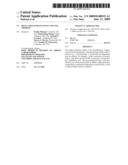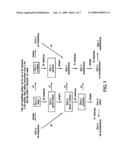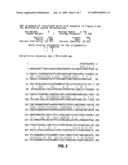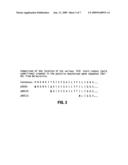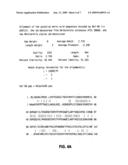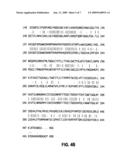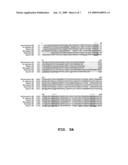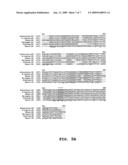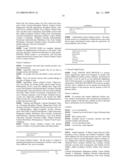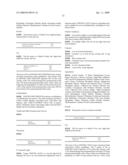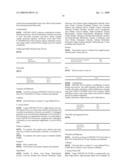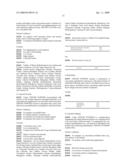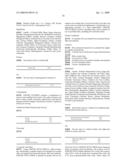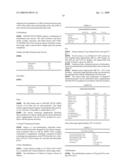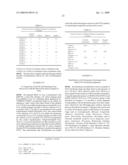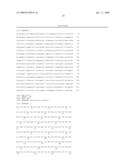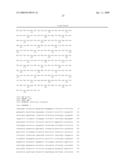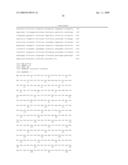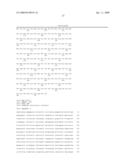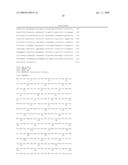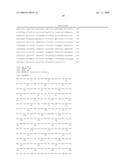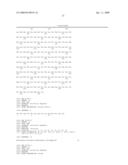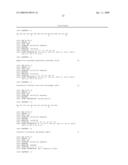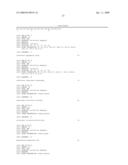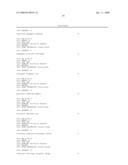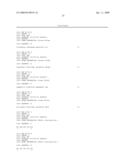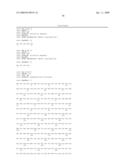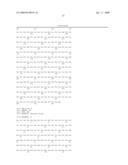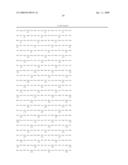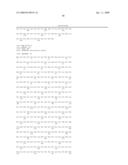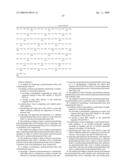Patent application title: Delta 6-Desaturase Genes and Uses Thereof
Inventors:
Pradip Mukerji (Columbus, OH, US)
Yung-Sheng Huang (Upper Arlington, OH, US)
Amanda E. Leonard (Columbus, OH, US)
Suzette L. Pereira (Westerville, OH, US)
Jennifer M. Thurmond (Columbus, OH, US)
IPC8 Class: AC12P764FI
USPC Class:
435134
Class name: Micro-organism, tissue cell culture or enzyme using process to synthesize a desired chemical compound or composition preparing oxygen-containing organic compound fat; fatty oil; ester-type wax; higher fatty acid (i.e., having at least seven carbon atoms in an unbroken chain bound to a carboxyl group); oxidized oil or fat
Publication date: 2009-06-11
Patent application number: 20090148919
Claims:
1. A method for producing a polyunsaturated fatty acid comprising the
steps of:a) isolating a nucleic acid sequence comprising or complementary
to a nucleotide sequence:i) encoding a polypeptide comprising an amino
acid sequence having at least 90% identity to SEQ ID NO:8 orii) having at
least 90% identity to the nucleotide sequence SEQ ID NO:7;b) constructing
a vector comprising said isolated nucleotide sequence;c) introducing said
vector into a host cell for a time and under conditions sufficient for
expression of a Δ6-desaturase; andd) exposing said expressed
Δ6-desaturase to a substrate polyunsaturated fatty acid in order to
convert said substrate to a product polyunsaturated fatty acid.
2. The method according to claim 1, wherein said substrate polyunsaturated fatty acid is linoleic acid or α-linolenic acid and said product polyunsaturated fatty acid is γ-linolenic acid or stearidonic acid, respectively.
3. The method according to claim 1 further comprising the step of exposing said product polyunsaturated fatty acid to an elongase in order to convert said product polyunsaturated fatty acid to another polyunsaturated fatty acid.
4. The method according to claim 3 wherein said product polyunsaturated fatty acid is γ-linolenic acid or stearidonic acid and said another polyunsaturated fatty acid is dihomo-.gamma.-linolenic acid or eicosatetraenoic acid, respectively.
5. A method of producing a polyunsaturated fatty acid comprising the steps of:a) exposing a substrate monounsaturated or polyunsaturated fatty acid to a desaturase in order to convert said substrate to a product polyunsaturated fatty acid; andb) exposing said product polyunsaturated fatty acid of step a) to a Δ6-desaturase comprising the amino acid sequence SEQ ID NO:8 in order to convert said product polyunsaturated fatty acid to a final product polyunsaturated fatty acid.
6. The method of claim 5 wherein said substrate monounsaturated fatty acid is oleic acid and said polyunsaturated fatty acid is linoleic acid.
7. The method of claim 5 wherein said final product polyunsaturated fatty acid is γ-linolenic acid or stearidonic acid.
8. A method for producing a polyunsaturated fatty acid comprising the steps of:a) isolating a nucleic acid sequence comprising or complementary to a nucleotide sequence:iii) encoding a polypeptide comprising an amino acid sequence having at least 90% identity to the amino acid sequence SEQ ID NO:8 oriv) having at least 90% identity to the nucleotide sequence SEQ ID NO:7;b) constructing a vector comprising: i) said isolated nucleotide sequence, ii) an isolated nucleotide sequence encoding an elongase and iii) an isolated nucleotide sequence encoding a Δ5-desaturase;c) introducing said vector into a host cell for a time and under conditions sufficient for expression of said Δ6-desaturase, said elongase and said Δ5-desaturase; andd) exposing said expressed Δ6-desaturase, said expressed elongase and said expressed Δ5-desaturase to a substrate polyunsaturated fatty acid in order to convert said substrate to a product polyunsaturated fatty acid, said product polyunsaturated fatty acid to another polyunsaturated fatty acid and said another polyunsaturated fatty acid to a final product polyunsaturated fatty acid.
9. The method according to claim 8, wherein said substrate polyunsaturated fatty acid is linoleic acid, said product polyunsaturated fatty acid is γ-linolenic acid, said another polyunsaturated fatty acid is dihomo-.gamma.-linolenic acid and said final product polyunsaturated fatty acid is arachidonic acid.
10. The method according to claim 8 wherein said substrate polyunsaturated fatty acid is α-linolenic acid, said product polyunsaturated fatty acid is stearidonic acid, said another polyunsaturated fatty acid is eicosatetraenoic acid and said final product polyunsaturated fatty acid is eicosapentaenoic acid.
Description:
[0001]This application is a divisional of allowed U.S. patent application
Ser. No. 10/931,626, which is incorporated in entirety by reference.
BACKGROUND OF THE INVENTION
[0002]1. Technical Field
[0003]The subject invention relates to the identification and isolation of genes that encode an enzyme (i.e., Δ6-desaturase) involved in the synthesis of polyunsaturated fatty acids and to uses thereof. In particular, Δ6-desaturase catalyzes the conversion of, for example, linoleic acid (C18:2n-6) to γ-linolenic acid (C18:3n-6) and α-linolenic acid (C18:3n-3) to stearidonic acid (C18:4n-3). The converted products may then be utilized as substrates in the production of other polyunsaturated fatty acids (PUFAs). The products or other polyunsaturated fatty acids may be added to pharmaceutical compositions, nutritional compositions, animal feeds as well as other products such as cosmetics.
[0004]2. Background Information
[0005]Desaturases are critical in the production of long-chain polyunsaturated fatty acids that have many important functions. For example, polyunsaturated fatty acids (PUFAs) are important components of the plasma membrane of a cell, where they are found in the form of phospholipids. They also serve as precursors to mammalian prostacyclins, eicosanoids, leukotrienes and prostaglandins.
[0006]Additionally, PUFAs are necessary for the proper development of the developing infant brain as well as for tissue formation and repair. In view of the biological significance of PUFAs, attempts are being made to produce them, as well as intermediates leading to their production, in an efficient manner.
[0007]A number of enzymes, most notably desaturases and elongases, are involved in PUFA biosynthesis (see FIG. 1). For example, an elongase (elo) catalyzes the conversion of γ-linolenic acid (GLA) to dihomo-γ-linolenic acid (DGLA) and of stearidonic acid (C18:4n-3) to (n-3)-eicosatetraenoic acid (C20:4n-3). Linoleic acid (LA, C18:2n-9,12 or C18:2n-6) is produced from oleic acid (C18:1-Δ9) by a Δ12-desaturase. GLA (C18:3n-6,9,12) is produced from linoleic acid by a Δ6-desaturase.
[0008]It must be noted that animals cannot desaturate beyond the Δ9 position and therefore cannot convert oleic acid into linoleic acid. Likewise, γ-linolenic acid (ALA, C18:3n-9,12,15) cannot be synthesized by mammals. However, γ-linolenic acid can be converted to stearidonic acid (STA, C18:4n-6,9,12,15) by a Δ6-desaturase (see PCT publication WO 96/13591 and The FASEB Journal, Abstracts, Part I, Abstract 3093, page Δ532 (Experimental Biology 98, San Francisco, Calif., Apr. 18-22, 1998); see also U.S. Pat. No. 5,552,306), followed by elongation to (n-3)-eicosatetraenoic acid (C20:4n-8,11,14,17) in mammals and algae. This polyunsaturated fatty acid (i.e., C20:4n-8,11,14,17) can then be converted to eicosapentaenoic acid (EPA, C20:5n-5,8,11,14,17) by a Δ5-desaturase. EPA can then, in turn, be converted to ω3-docosapentaenoic acid (C22:5n-3) by an elongase.
[0009]Other eukaryotes, including fungi and plants, have enzymes which desaturate at carbon 12 (see PCT publication WO 94/11516 and U.S. Pat. No. 5,443,974) and carbon 15 (see PCT publication WO 93/11245). The major polyunsaturated fatty acids of animals therefore are either derived from diet and/or from desaturation and elongation of linoleic acid or γ-linolenic acid. In view of these difficulties, it is of significant interest to isolate genes involved in PUFA synthesis from species that naturally produce these fatty acids and to express these genes in a microbial, plant, or animal system which can be altered to provide production of commercial quantities of one or more PUFAs.
[0010]In view of the above discussion, there is a definite need for the Δ6-desaturase enzyme, the respective genes encoding this enzyme, as well as recombinant methods of producing this enzyme. Additionally, a need exists for oils containing levels of PUFAs beyond those naturally present as well as those enriched in novel PUFAs. Such oils can only be made by isolation and expression of the Δ6-desaturase genes.
[0011]All U.S. patents and publications referred to herein are hereby incorporated in their entirety by reference.
SUMMARY OF THE INVENTION
[0012]The present invention includes an isolated nucleotide sequence or fragment thereof encoding a polypeptide having desaturase activity, wherein said polypeptide comprises an amino acid sequence having at least 90% amino acid sequence identity to an amino acid sequence selected from the group consisting of SEQ ID NO:2, SEQ ID NO:4, SEQ ID NO:6 and SEQ ID NO:8.
[0013]Additionally, the present invention encompasses an isolated nucleic acid sequence or fragment thereof comprising, or complementary to, a nucleotide sequence having at least 90% nucleotide sequence identity to a nucleotide sequence selected from the group consisting of SEQ ID NO:1, SEQ ID NO:3, SEQ ID NO:5 and SEQ ID NO:7.
[0014]The nucleotide sequences described above encode a functionally active desaturase that utilizes a monounsaturated or polyunsaturated fatty acid as a substrate. The nucleotide sequences may be derived for example, from Delacroixia coronatus. The present invention also includes purified proteins and fragments thereof encoded by the above-referenced nucleotide sequences.
[0015]In particular, the present invention also includes a purified polypeptide which desaturates polyunsaturated fatty acids at carbon 6 and has an amino acid sequence having at least 90% amino acid identity to an amino acid sequence selected from the group consisting of SEQ ID NO:2, SEQ ID NO:4, SEQ ID NO:6 and SEQ ID NO:8.
[0016]Additionally, the present invention includes a method of producing a desaturase comprising the steps of: isolating a nucleotide sequence comprising or complementary to a nucleotide sequence encoding a polypeptide comprising an amino acid sequence having at least 90% identity to an amino acid sequence of SEQ ID NO:2, SEQ ID NO:4, SEQ ID NO:6 and SEQ ID NO:8; constructing a vector comprising: i) the isolated nucleotide sequence operably linked to ii) a promoter; and introducing said vector into a host cell for a time and under conditions sufficient for expression of the desaturase. The host cell may be, for example, a eukaryotic cell or a prokaryotic cell. In particular, the prokaryotic cell may be, for example, E. coli, cyanobacteria or B. subtilis. The eukaryotic cell may be, for example, a mammalian cell, an insect cell, a plant cell or a fungal cell (e.g., a yeast cell such as Saccharomyces cerevisiae, Saccharomyces carlsbergensis, Candida spp., Lipomyces starkey, Yarrowia lipolytica, Kluyveromyces spp., Hansenula spp., Trichoderma spp. or Pichia spp.). Other fungal hosts such as Rizopus spp., Aspergillus spp. and Mucor spp. may also be utilized.
[0017]Moreover, the present invention also includes a vector comprising: an isolated nucleotide sequence comprising or complementary to a nucleotide sequence encoding a polypeptide having an amino acid sequence having at least 90% amino acid identity to an amino acid sequence selected from the group consisting of SEQ ID NO:2, SEQ ID NO:4, SEQ ID NO:6 and SEQ ID NO:8, operably linked to a regulatory sequence (e.g., a promoter). The invention also includes a host cell comprising this vector. The host cell may be, for example, a eukaryotic cell or a prokaryotic cell. Suitable eukaryotic cells and prokaryotic cells are as defined above.
[0018]Additionally, the present invention includes an isolated plant cell, plant or plant tissue comprising the above vector, wherein expression of the nucleotide sequence of the vector results in production of a polyunsaturated fatty acid by the plant cell, plant or plant tissue. The polyunsaturated fatty acid may be, for example, selected from the group consisting of γ-linolenic acid or stearidonic acid. The invention also includes one or more plant oils or acids expressed by the above plant cell, plant or plant tissue.
[0019]Additionally, the present invention also encompasses a transgenic plant comprising the above vector, wherein expression of the nucleotide sequence of the vector results in production of a polyunsaturated fatty acid in seeds of the transgenic plant.
[0020]The present invention also includes a method ("first method") for producing a polyunsaturated fatty acid comprising the steps of: isolating a nucleic acid sequence comprising or complementary to a nucleotide sequence encoding a polypeptide comprising an amino acid sequence having at least 90% amino acid sequence identity to an amino acid sequence selected from the group consisting of SEQ ID NO:2, SEQ ID NO:4, SEQ ID NO:6 and SEQ ID NO:8 or 90% nucleotide sequence identity to a nucleotide sequence selected from the group consisting of SEQ ID NO:1, SEQ ID NO:3, SEQ ID NO:5 and SEQ ID NO:7; constructing a vector comprising the isolated nucleotide sequence; introducing the vector into a host cell for a time and under conditions sufficient for expression of Δ6-desaturase; and exposing the expressed Δ6-desaturase to a substrate polyunsaturated fatty acid in order to convert the substrate to a product polyunsaturated fatty acid. The substrate polyunsaturated fatty acid may be, for example, linolenic acid or α-linolenic acid, and the product polyunsaturated fatty acid may be, for example, γ-linolenic acid or stearidonic acid, respectively. This method may further comprise the step of exposing the product polyunsaturated fatty acid to another enzyme (e.g., an elongase) in order to convert the product polyunsaturated fatty acid to another polyunsaturated fatty acid (i.e., "second" method). In this method containing the additional step (i.e., "second" method), the product polyunsaturated fatty acid may be, for example, γ-linolenic acid or stearidonic acid and the "another" polyunsaturated fatty acid may be, for example, dihomo-γ-linolenic acid or eicosatetraenoic acid.
[0021]Also, the present invention includes a method of producing a polyunsaturated fatty acid comprising the steps of: exposing a substrate monounsaturated or polyunsaturated fatty acid to an enzyme (e.g., an elongase or desaturase) in order to convert the substrate to a product polyunsaturated fatty acid; and exposing the product polyunsaturated fatty acid to a Δ6-desaturase comprising the amino acid sequence selected from the group consisting of SEQ ID NO:2, SEQ ID NO:4, SEQ ID NO:6 and SEQ ID NO:8, in order to convert the product polyunsaturated fatty acid to a final product polyunsaturated fatty acid.
[0022]For example, a substrate polyunsaturated fatty acid (e.g., linoleic acid) may be exposed to a ω3-desaturase (e.g., Δ15-desaturase) in order to convert the substrate to a "product" polyunsaturated fatty acid (e.g., α-linolenic acid). The product polyunsaturated fatty acid may then be converted to a "final" product polyunsaturated fatty acid (e.g., stearidonic acid) by exposure to the Δ6-desaturase of the present invention (see FIG. 1). Alternatively, a substrate monounsaturated fatty acid such as oleic acid may be exposed to a desaturase (e.g., Δ12-desaturase) in order to convert the substrate to a product polyunsaturated fatty acid such as linoleic acid. The product polyunsaturated fatty acid may then be converted to the final product polyunsaturated fatty acid, γ-linolenic acid by exposure to the Δ6-desaturase of the present invention. Thus, the Δ6-desaturase is utilized in the last step of the method in order to create the "final" desired product. As another example, one may expose linoleic acid to a Δ6-desaturase in order to create γ-linolenic acid (GLA), and then expose the GLA to an elongase to create dihomo-γ-linolenic acid (DGLA) and then expose DGLA to a Δ5-desaturase in order to create arachidonic acid (AA). The AA may then be exposed to an elongase in order to convert it to adrenic acid. Finally, the adrenic acid may be exposed to Δ4-desaturase in order to convert it to ω6-docosapentaenoic acid (see FIG. 1). Thus, the method involves the utilization of a linoleic acid substrate and a series of desaturase and elongase enzymes, in addition to the Δ6-desaturase, in order to arrive at the final product. (Possible substrates include those shown in FIG. 1, for example, linoleic acid and α-linolenic acid.)
[0023]The present invention also encompasses a composition comprising at least one polyunsaturated fatty acid selected from the group consisting of the "product" polyunsaturated fatty acid produced according to the methods described above and the "another" polyunsaturated fatty acid produced according to the methods described above. The product polyunsaturated fatty acid may be, for example, γ-linolenic acid or stearidonic acid. The another polyunsaturated fatty acid may be, for example, dihomo-γ-linolenic acid or eicosatetraenoic acid.
[0024]Additionally, the present invention encompasses a method of preventing or treating a condition caused by insufficient intake of polyunsaturated fatty acids comprising administering to the patient the composition above in an amount sufficient to effect prevention or treatment.
[0025]Moreover, the present invention also includes a further method for producing a polyunsaturated fatty acid. This method comprises the steps of: a) isolating a nucleic acid sequence comprising or complementary to a nucleotide sequence: i) encoding a polypeptide comprising an amino acid sequence having at least 90% identity to an amino acid sequence selected from the group consisting of SEQ ID NO:2, SEQ ID NO:4, SEQ ID NO:6 and SEQ ID NO:8 or ii) having at least 90% identity to a nucleotide sequence selected from the group consisting of SEQ ID NO:1, SEQ ID NO:3, SEQ ID NO:5 and SEQ ID NO:7; b) constructing a vector comprising: i) the isolated nucleotide sequence, ii) an isolated nucleotide sequence encoding an elongase and iii) an isolated nucleotide sequence encoding a Δ5-desaturase; c) introducing the vector into a host cell for a time and under conditions sufficient for expression of the Δ6-desaturase, the elongase and said Δ5-desaturase; and d) exposing the expressed Δ6-desaturase, the expressed elongase and the expressed Δ5-desaturase to a substrate polyunsaturated fatty acid in order to convert the substrate to a product polyunsaturated fatty acid, the product polyunsaturated fatty acid to another polyunsaturated fatty acid and the another polyunsaturated fatty acid to a final product polyunsaturated fatty acid. For example, the substrate polyunsaturated fatty acid may be linoleic acid, the product polyunsaturated fatty acid may be γ-linolenic acid, the another polyunsaturated fatty acid may be dihomo-γ-linolenic acid and the final product polyunsaturated fatty acid may be arachidonic acid. Alternatively, the substrate polyunsaturated fatty acid may be α-linolenic acid, the product polyunsaturated fatty acid may be stearidonic acid, the another polyunsaturated fatty acid may be eicosatetraenoic acid and the final product polyunsaturated fatty acid may be eicosapentaenoic acid.
[0026]Additionally, the present invention includes an isolated nucleic acid sequence or fragment thereof which hybridizes, under moderate or high stringency conditions, to a nucleic acid sequence selected from the group consisting of SEQ ID NO:1, SEQ ID NO:3, SEQ ID NO:5 and SEQ ID NO:7.
[0027]The present invention also encompasses an isolated nucleic acid or fragment thereof, which hybridizes, under moderate or high stringency conditions, to an isolated nucleic acid sequence encoding a polypeptide having desaturase activity, wherein the amino acid sequence of said polypeptide has at least 90% identity to an amino acid sequence selected from the group consisting of SEQ ID NO:2, SEQ ID NO:4, SEQ ID NO:6 and SEQ ID NO:8.
BRIEF DESCRIPTION OF THE DRAWINGS
[0028]FIG. 1 illustrates the fatty acid biosynthetic pathway and the role of Δ6-desaturase in this pathway. Major pathway intermediates found in the total lipid profile of Delacroixia are boxed.
[0029]FIG. 2 illustrates the GAP alignment of the translated amino acid sequence of (SEQ ID NO:2) and the Mortierella alpina Δ6-desaturase (SEQ ID NO:40).
[0030]FIG. 3 illustrates the comparison of the location of the various Met-encoding `ATG` start codons (bold, underlined) created in the putative desaturase gene sequence (Del-D6) from Delacroixia, which encodes the related, presented amino acid sequence (Consensus=SEQ ID NO:41; pRDC8=SEQ ID NO:42; pRDC10=SEQ ID NO:43; pRDC12=SEQ ID NO:44).
[0031]FIGS. 4A and 4B illustrate the alignment of the putative amino acid sequence encoded by Del-D6 (in pRDC12) (see SEQ ID NO:8) (i.e., the Δ6-desaturase from Delacroixia coronatus ATCC 28565) and the Mortierella alpina Δ6-desaturase (see SEQ ID NO:40).
[0032]FIGS. 5A and 5B illustrate the alignment of the putative amino acid sequence encoded by Del-D6 (in pRDC12) (SEQ ID NO:8) with known Δ6-desaturase sequences from Mortierella alpina (Accession #AAF08685) (SEQ ID NO:40), Phaeodactylum tricornatum (Accession #AAL92563) (SEQ ID NO:37), Rhizopus oryzae (Accession #AAS93682) (SEQ ID NO:38), Pythium irregulare (Accession # AAL13310) (SEQ ID NO:39), and Mucor circinelloides (Accession # BAB69055) (SEQ ID NO:45). Identical residues are underlined and the conserved histidine-box motifs as well as the conserved cytochrome b5 domain are boxed.
DETAILED DESCRIPTION OF THE INVENTION
[0033]The subject invention relates to the nucleotide and translated amino acid sequences of the Δ6-desaturase genes derived from the fungus Delacroixia coronata. Furthermore, the subject invention also includes uses of the genes and of the enzymes encoded by this gene. For example, the genes and encoded, corresponding enzymes may be used in the production of polyunsaturated fatty acids such as, for instance, γ-linolenic acid and stearidonic acid which may be added to pharmaceutical compositions, nutritional compositions and to other valuable products.
The Δ6-Desaturase Genes and Enzymes Encoded thereby
[0034]As noted above, the enzymes encoded by the Δ6-desaturase genes of the present invention are essential in the production of polyunsaturated fatty acids. SEQ ID NO: 1 is the consensus nucleotide sequence of the putative Δ6-desaturase from Delacroixia coronatus, and SEQ ID NO: is the consensus amino acid sequence of the putative Δ6-desaturase from Delacroixia coronatus. The nucleotide sequences of the isolated Delacroixia coronatus Δ6-desaturase genes, which differed based upon the plasmid created (see Example II), are shown in SEQ ID NO:3 (construct pRDC8), SEQ ID NO:5 (construct pRDC10) and SEQ ID NO:7 (construct pRDC 12), and the amino acid sequences of the corresponding purified proteins are shown in SEQ ID NO:4 (construct pRDC8), SEQ ID NO:6 (construct pRDC 10) and SEQ ID NO:8 (construct pRDC12), respectively.
[0035]It should be noted that the present invention also encompasses isolated nucleotide sequences (and the corresponding encoded proteins) having sequences comprising, corresponding to, identical to, or complementary to at least about 70%, preferably at least about 80%, and more preferably at least about 90% identity to SEQ ID NO:1, SEQ ID NO:3, SEQ ID NO:5 or SEQ ID NO:7. (All integers (and portions thereof) between 70% and 100% are also considered to be within the scope of the present invention with respect to percent identity.) Such sequences may be derived from any source, either isolated from a natural source, or produced via a semi-synthetic route, or synthesized de novo. In particular, such sequences may be isolated or derived from sources other than described in the examples (e.g., bacteria, fungus, algae, C. elegans, mouse or human).
[0036]Furthermore, the present invention also encompasses fragments and derivatives of the nucleic acid sequences of the present invention (i.e., SEQ ID NO:1, SEQ ID NO:3, SEQ ID NO:5 and SEQ ID NO:7), as well as of the sequences derived from other sources, and having the above-described complementarity, identity or correspondence. Functional equivalents of the above full length sequences and fragments (i.e., sequences having Δ6-desaturase activity, as appropriate) are also encompassed by the present invention.
[0037]For purposes of the present invention, a "fragment" of a nucleotide sequence is defined as a contiguous sequence of approximately at least 6, preferably at least about 8, more preferably at least about 10 nucleotides, and even more preferably at least about 15 nucleotides corresponding to a region of the specified nucleotide sequence.
[0038]The invention also includes a purified polypeptide which desaturates polyunsaturated fatty acids at the carbon 6 position and has at least about 70% amino acid similarity or identity, preferably at least about 80% amino acid similarity or identity and more preferably at least about 90% amino acid similarity or identity to the amino acid sequences of SEQ ID NO:2, SEQ ID NO:4, SEQ ID NO:6 or SEQ ID NO:8 of the above-noted proteins which are, in turn, encoded by the above-described nucleotide sequences.
[0039]The term "identity" refers to the relatedness of two sequences on a nucleotide-by-nucleotide basis over a particular comparison window or segment. Thus, identity is defined as the degree of sameness, correspondence or equivalence between the same strands (either sense or antisense) of two DNA segments (or two amino acid sequences). "Percentage of sequence identity" is calculated by comparing two optimally aligned sequences over a particular region, determining the number of positions at which the identical base or amino acid occurs in both sequences in order to yield the number of matched positions, dividing the number of such positions by the total number of positions in the segment being compared and multiplying the result by 100. Optimal alignment of sequences may be conducted by the algorithm of Smith & Waterman, Appl. Math. 2:482 (1981), by the algorithm of Needleman & Wunsch, J. Mol. Biol. 48:443 (1970), by the method of Pearson & Lipman, Proc. Natl. Acad. Sci. (USA) 85:2444 (1988) and by computer programs which implement the relevant algorithms (e.g., Higgins et al., CABIOS. 5L151-153 (1989)), FASTDB (Intelligenetics), BLAST (National Center for Biomedical Information; Altschul et al., Nucleic Acids Research 25:3389-3402 (1997)), PILEUP (Genetics Computer Group, Madison, Wis.) or GAP, BESTFIT, FASTA and TFASTA (Wisconsin Genetics Software Package Release 7.0, Genetics Computer Group, Madison, Wis.). (See U.S. Pat. No. 5,912,120.)
[0040]For purposes of the present invention, "complementarity is defined as the degree of relatedness between two DNA segments. It is determined by measuring the ability of the sense strand of one DNA segment to hybridize with the anti-sense strand of the other DNA segment, under appropriate conditions, to form a double helix. A "complement" is defined as a sequence which pairs to a given sequence based upon the canonic base-pairing rules. For example, a sequence A-G-T in one nucleotide strand is "complementary" to T-C-A in the other strand.
[0041]In the double helix, adenine appears in one strand, thymine appears in the other strand. Similarly, wherever guanine is found in one strand, cytosine is found in the other. The greater the relatedness between the nucleotide sequences of two DNA segments, the greater the ability to form hybrid duplexes between the strands of the two DNA segments.
[0042]"Similarity" between two amino acid sequences is defined as the presence of a series of identical as well as conserved amino acid residues in both sequences. The higher the degree of similarity between two amino acid sequences, the higher the correspondence, sameness or equivalence of the two sequences. ("Identity between two amino acid sequences is defined as the presence of a series of exactly alike or invariant amino acid residues in both sequences.) The definitions of "complementarity", "identity" and "similarity" are well known to those of ordinary skill in the art.
[0043]"Encoded by" refers to a nucleic acid sequence which codes for a polypeptide sequence, wherein the polypeptide sequence or a portion thereof contains an amino acid sequence of at least 3 amino acids, more preferably at least 8 amino acids, and even more preferably at least 15 amino acids from a polypeptide encoded by the nucleic acid sequence.
[0044]The present invention also encompasses an isolated nucleotide sequence which encodes a PUFA having desaturase activity (i.e., Δ6-desaturase activity) and that is hybridizable, under moderately stringent conditions, to a nucleic acid having a nucleotide sequence comprising or complementary to the nucleotide sequences described above (see SEQ ID NO:1, SEQ ID NO:3, SEQ ID NO:5 and SEQ ID NO:7). A nucleic acid molecule is "hybridizable" to another nucleic acid molecule when a single-stranded form of the nucleic acid molecule can anneal to the other nucleic acid molecule under the appropriate conditions of temperature and ionic strength (see Sambrook et al., "Molecular Cloning: A Laboratory Manual, Second Edition (1989), Cold Spring Harbor Laboratory Press, Cold Spring Harbor, N.Y.)). The conditions of temperature and ionic strength determine the "stringency" of the hybridization.
[0045]The term "hybridization" as used herein is generally used to mean hybridization of nucleic acids at appropriate conditions of stringency as would be readily evident to those skilled in the art depending upon the nature of the probe sequence and target sequences. Conditions of hybridization and washing are well known in the art, and the adjustment of conditions depending upon the desired stringency by varying incubation time, temperature and/or ionic strength of the solution are readily accomplished. See, or example, Sambrook, J. et al., Molecular Cloning: A Laboratory Manual, 2nd edition, Cold spring harbor Press, Cold Spring harbor, N.Y., 1989, as noted above and incorporated herein by reference. (See also Short Protocols in Molecular Biology, ed. Ausubel et al. and Tijssen, Techniques in Biochemistry and Molecular Biology-Hybridization with Nucleic Acid Probes, "Overview of principles of hybridization and the strategy of nucleic acid assays" (1993), both incorporated herein by reference.) Specifically, the choice of conditions is dictated by the length of the sequences being hybridized, in particular, the length of the probe sequence, the relative G-C content of the nucleic acids and the amount of mismatches to be permitted. Low stringency conditions are preferred when partial hybridization between strands that have lesser degrees of complementarity is desired. When perfect or near perfect complementarity is desired, high stringency conditions are preferred. For typical high stringency conditions, the hybridization solution contains 6×S.S.C., 0.01 M EDTA, 1×Denhardt's solution and 0.5% SDS. Hybridization is carried out at about 68 degrees Celsius for about 3 to 4 hours for fragments of cloned DNA and for about 12 to about 16 hours for total eukaryotic DNA. For moderate stringencies, one may utilize filter pre-hybridizing and hybridizing with a solution of 3× sodium chloride, sodium citrate (SSC), 50% formamide (0.1 M of this buffer at pH 7.5) and 5×Denhardt's solution. One may then pre-hybridize at 37 degrees Celsius for 4 hours, followed by hybridization at 37 degrees Celsius with an amount of labeled probe equal to 3,000,000 cpm total for 16 hours, followed by a wash in 2×SSC and 0.1% SDS solution, a wash of 4 times for 1 minute each at room temperature and 4 times at 60 degrees Celsius for 30 minutes each. Subsequent to drying, one exposes to film. For lower stringencies, the temperature of hybridization is reduced to about 12 degrees Celsius below the melting temperature (Tm) of the duplex. The Tm is known to be a function of the G-C content and duplex length as well as the ionic strength of the solution.
[0046]"Hybridization" requires that two nucleic acids contain complementary sequences. However, depending on the stringency of the hybridization, mismatches between bases may occur. As noted above, the appropriate stringency for hybridizing nucleic acids depends on the length of the nucleic acids and the degree of complementation. Such variables are well known in the art. More specifically, the greater the degree of similarity or homology between two nucleotide sequences, the greater the value of Tm for hybrids of nucleic acids having those sequences. For hybrids of greater than 100 nucleotides in length, equations for calculating Tm have been derived (see Sambrook et al., supra). For hybridization with shorter nucleic acids, the position of mismatches becomes more important, and the length of the oligonucleotide determines its specificity (see Sambrook et al., supra).
[0047]As used herein, an "isolated nucleic acid fragment or sequence" is a polymer of RNA or DNA that is single- or double-stranded, optionally containing synthetic, non-natural or altered nucleotide bases. An isolated nucleic acid fragment in the form of a polymer of DNA may be comprised of one or more segments of cDNA, genomic DNA or synthetic DNA. (A "fragment" of a specified polynucleotide refers to a polynucleotide sequence which comprises a contiguous sequence of approximately at least about 6 nucleotides, preferably at least about 8 nucleotides, more preferably at least about 10 nucleotides, and even more preferably at least about 15 nucleotides, and most preferable at least about 25 nucleotides identical or complementary to a region of the specified nucleotide sequence.) Nucleotides (usually found in their 5'-monophosphate form) are referred to by their single letter designation as follows: "A" for adenylate or deoxyadenylate (for RNA or DNA, respectively), "C" for cytidylate or deoxycytidylate, "G" for guanylate or deoxyguanylate, "U" for uridylate, "T" for deoxythymidylate, "R" for purines (A or G), "Y" for pyrimidines (C or T), "K" for G or T, "H" for A or C or T, "I" for inosine, and "N" for any nucleotide.
[0048]The terms "fragment or subfragment that is functionally equivalent" and "functionally equivalent fragment or subfragment" are used interchangeably herein. These terms refer to a portion or subsequence of an isolated nucleic acid fragment in which the ability to alter gene expression or produce a certain phenotype is retained whether or not the fragment or subfragment encodes an active enzyme. For example, the fragment or subfragment can be used in the design of chimeric constructs to produce the desired phenotype in a transformed plant. Chimeric constructs can be designed for use in co-suppression or antisense by linking a nucleic acid fragment or subfragment thereof, whether or not it encodes an active enzyme, in the appropriate orientation relative to a plant promoter sequence.
[0049]The terms "homology", "homologous", "substantially similar" and "corresponding substantially" are used interchangeably herein. They refer to nucleic acid fragments wherein changes in one or more nucleotide bases does not affect the ability of the nucleic acid fragment to mediate gene expression or produce a certain phenotype. These terms also refer to modifications of the nucleic acid fragments of the instant invention such as deletion or insertion of one or more nucleotides that do not substantially alter the functional properties of the resulting nucleic acid fragment relative to the initial, unmodified fragment. It is therefore understood, as those skilled in the art will appreciate, that the invention encompasses more than the specific exemplary sequences.
[0050]"Gene" refers to a nucleic acid fragment that expresses a specific protein, including regulatory sequences preceding (5' non-coding sequences) and following (3' non-coding sequences) the coding sequence.
[0051]"Native gene" refers to a gene as found in nature with its own regulatory sequences. In contrast, "chimeric construct" refers to a combination of nucleic acid fragments that are not normally found together in nature. Accordingly, a chimeric construct may comprise regulatory sequences and coding sequences that are derived from different sources, or regulatory sequences and coding sequences derived from the same source, but arranged in a manner different than that normally found in nature. (The term "isolated" means that the sequence is removed from its natural environment.)
[0052]A "foreign" gene refers to a gene not normally found in the host organism, but that is introduced into the host organism by gene transfer. Foreign genes can comprise native genes inserted into a non-native organism, or chimeric constructs. A "transgene" is a gene that has been introduced into the genome by a transformation procedure.
[0053]"Coding sequence refers to a DNA sequence that codes for a specific amino acid sequence. "Regulatory sequences" refer to nucleotide sequences located upstream (5' non-coding sequences), within, or downstream (3' non-coding sequences) of a coding sequence, and which influence the transcription, RNA processing or stability, or translation of the associated coding sequence. Regulatory sequences may include, but are not limited to, promoters, translation leader sequences, introns, and polyadenylation recognition sequences.
[0054]"Promoter" refers to a DNA sequence capable of controlling the expression of a coding sequence or functional RNA. The promoter sequence consists of proximal and more distal upstream elements, the latter elements often referred to as enhancers. Accordingly, an "enhancer" is a DNA sequence which can stimulate promoter activity and may be an innate element of the promoter or a heterologous element inserted to enhance the level or tissue-specificity of a promoter. Promoter sequences can also be located within the transcribed portions of genes, and/or downstream of the transcribed sequences. Promoters may be derived in their entirety from a native gene, or be composed of different elements derived from different promoters found in nature, or even comprise synthetic DNA segments. It is understood by those skilled in the art that different promoters may direct the expression of a gene in different tissues or cell types, or at different stages of development, or in response to different environmental conditions. Promoters which cause a gene to be expressed in most host cell types at most times are commonly referred to as "constitutive promoters". New promoters of various types useful in plant cells are constantly being discovered; numerous examples may be found in the compilation by Okamuro and Goldberg, Biochemistry of Plants 15:1-82 (1989). It is further recognized that since in most cases the exact boundaries of regulatory sequences have not been completely defined, DNA fragments of some variation may have identical promoter activity.
[0055]An "intron" is an intervening sequence in a gene that does not encode a portion of the protein sequence. Thus, such sequences are transcribed into RNA but are then excised and are not translated. The term is also used for the excised RNA sequences. An "exon" is a portion of the gene sequence that is transcribed and is found in the mature messenger RNA derived from the gene, but is not necessarily a part of the sequence that encodes the final gene product.
[0056]The "translation leader sequence" refers to a DNA sequence located between the promoter sequence of a gene and the coding sequence. The translation leader sequence is present in the fully processed mRNA upstream of the translation start sequence. The translation leader sequence may affect processing of the primary transcript to mRNA, mRNA stability or translation efficiency. Examples of translation leader sequences have been described (Turner, R. and Foster, G. D. (1995) Molecular Biotechnology 3:225).
[0057]The "3' non-coding sequences" refer to DNA sequences located downstream of a coding sequence and include polyadenylation recognition sequences and other sequences encoding regulatory signals capable of affecting mRNA processing or gene expression. The polyadenylation signal is usually characterized by affecting the addition of polyadenylic acid tracts to the 3' end of the mRNA precursor. The use of different 3' non-coding sequences is exemplified by Ingelbrecht et al., Plant Cell 1:671-680 (1989).
[0058]"RNA transcript" refers to the product resulting from RNA polymerase-catalyzed transcription of a DNA sequence. When the RNA transcript is a perfect complementary copy of the DNA sequence, it is referred to as the primary transcript or it may be a RNA sequence derived from post-transcriptional processing of the primary transcript and is referred to as the mature RNA. "Messenger RNA (mRNA)" refers to the RNA that is without introns and that can be translated into protein by the cell. "cDNA" refers to a DNA that is complementary to and synthesized from a mRNA template using the enzyme reverse transcriptase. The cDNA can be single-stranded or converted into the double-stranded form using the Klenow fragment of DNA polymerase I. "Sense" RNA refers to RNA transcript that includes the mRNA and can be translated into protein within a cell or in vitro. "Antisense RNA" refers to an RNA transcript that is complementary to all or part of a target primary transcript or mRNA and that blocks the expression of a target gene (U.S. Pat. No. 5,107,065). The complementarity of an antisense RNA may be with any part of the specific gene transcript, i.e., at the 5' non-coding sequence, 3' non-coding sequence, introns, or the coding sequence. "Functional RNA" refers to antisense RNA, ribozyme RNA, or other RNA that may not be translated but yet has an effect on cellular processes.
[0059]The terms "complement" and "reverse complement" are used interchangeably herein with respect to mRNA transcripts, and are meant to define the antisense RNA of the message.
[0060]The term "endogenous RNA" refers to any RNA which is encoded by any nucleic acid sequence present in the genome of the host prior to transformation with the recombinant construct of the present invention, whether naturally-occurring or non-naturally occurring, i.e., introduced by recombinant means, mutagenesis, etc.
[0061]The term "non-naturally occurring" means artificial, not consistent with what is normally found in nature.
[0062]The term "operably linked" refers to the association of nucleic acid sequences on a single nucleic acid fragment so that the function of one is regulated by the other. For example, a promoter is operably linked with a coding sequence when it is capable of regulating the expression of that coding sequence (i.e., that the coding sequence is under the transcriptional control of the promoter). Coding sequences can be operably linked to regulatory sequences in a sense or antisense orientation. In another example, the complementary RNA regions of the invention can be operably linked, either directly or indirectly, 5' to the target mRNA, or 3' to the target mRNA, or within the target mRNA, or a first complementary region is 5' and its complement is 3' to the target mRNA.
[0063]The term "expression", as used herein, refers to the production of a functional end-product. Expression of a gene involves transcription of the gene and translation of the mRNA into a precursor or mature protein. "Antisense inhibition" refers to the production of antisense RNA transcripts capable of suppressing the expression of the target protein. "Co-suppression" refers to the production of sense RNA transcripts capable of suppressing the expression of identical or substantially similar foreign or endogenous genes (U.S. Pat. No. 5,231,020).
[0064]"Mature" protein refers- to a post-translationally processed polypeptide; i.e., one from which any pre- or propeptides present in the primary translation product have been removed. "Precursor" protein refers to the primary product of translation of mRNA; i.e., with pre- and pro-peptides still present. Pre- and pro-peptides may be but are not limited to intracellular localization signals.
[0065]"Stable transformation" refers to the transfer of a nucleic acid fragment into a genome of a host organism, resulting in genetically stable inheritance. In contrast, "transient transformation" refers to the transfer of a nucleic acid fragment into the nucleus, or DNA-containing organelle, of a host organism resulting in gene expression without integration or stable inheritance. Host organisms containing the transformed nucleic acid fragments are referred to as "transgenic" organisms. The preferred method of cell transformation of rice, corn and other monocots is the use of particle-accelerated or "gene gun" transformation technology (Klein et al., (1987) Nature (London) 327:70-73; U.S. Pat. No. 4,945,050), or an Agrobacterium-mediated method using an appropriate Ti plasmid containing the transgene (Ishida Y. et al., 1996, Nature Biotech. 14:745-750). The term "transformation" as used herein refers to both stable transformation and transient transformation.
[0066]Standard recombinant DNA and molecular cloning techniques used herein are well known in the art and are described more fully in Sambrook, J., Fritsch, E. F. and Maniatis, T., Molecular Cloning: A Laboratory Manual; Cold Spring Harbor Laboratory Press: Cold Spring Harbor, 1989 (hereinafter "Sambrook").
[0067]The term "recombinant" refers to an artificial combination of two otherwise separated segments of sequence, e.g., by chemical synthesis or by the manipulation of isolated segments of nucleic acids by genetic engineering techniques.
[0068]"PCR" or "Polymerase Chain Reaction" is a technique for the synthesis of large quantities of specific DNA segments, consists of a series of repetitive cycles (Perkin Elmer Cetus Instruments, Norwalk, Conn.). Typically, the double stranded DNA is heat denatured, the two primers complementary to the 3' boundaries of the target segment are annealed at low temperature and then extended at an intermediate temperature. One set of these three consecutive steps is referred to as a cycle.
[0069]Polymerase chain reaction ("PCR") is a powerful technique used to amplify DNA millions of fold, by repeated replication of a template, in a short period of time. (Mullis et al., Cold Spring Harbor Symp. Quant. Biol. 51:263-273 (1986); Erlich et al., European Patent Application No. 50,424; European Patent Application No. 84,796; European Patent Application No. 258,017; European Patent Application No. 237,362; Mullis, European Patent Application No. 201,184; Mullis et al., U.S. Pat. No. 4,683,202; Erlich, U.S. Pat. No. 4,582,788; and Saiki et al., U.S. Pat. No. 4,683,194). The process utilizes sets of specific in vitro synthesized oligonucleotides to prime DNA synthesis. The design of the primers is dependent upon the sequences of DNA that are desired to be analyzed. The technique is carried out through many cycles (usually 20-50) of melting the template at high temperature, allowing the primers to anneal to complementary sequences within the template and then replicating the template with DNA polymerase.
[0070]The products of PCR reactions are analyzed by separation in agarose gels followed by ethidium bromide staining and visualization with UV transillumination. Alternatively, radioactive dNTPs can be added to the PCR in order to incorporate label into the products. In this case the products of PCR are visualized by exposure of the gel to x-ray film. The added advantage of radiolabeling PCR products is that the levels of individual amplification products can be quantitated.
[0071]The terms "recombinant construct", "expression construct" and "recombinant expression construct" are used interchangeably herein. These terms refer to a functional unit of genetic material that can be inserted into the genome of a cell using standard methodology well known to one skilled in the art. Such construct may be itself or may be used in conjunction with a vector. If a vector is used then the choice of vector is dependent upon the method that will be used to transform host plants as is well known to those skilled in the art. For example, a plasmid vector can be used. The skilled artisan is well aware of the genetic elements that must be present on the vector in order to successfully transform, select and propagate host cells comprising any of the isolated nucleic acid fragments of the invention. The skilled artisan will also recognize that different independent transformation events will result in different levels and patterns of expression (Jones et al., (1985) EMBO J. 4:2411-2418; De Almeida et al., (1989) Mol. Gen. Genetics 218:78-86), and thus that multiple events must be screened in order to obtain lines displaying the desired expression level and pattern. Such screening may be accomplished by Southern analysis of DNA, Northern analysis of mRNA expression, Western analysis of protein expression, or phenotypic analysis.
Production of the Δ6-Desaturase Enyzme
[0072]Once the gene encoding the Δ6-desaturase enzyme has been isolated, it may then be introduced into either a prokaryotic or eukaryotic host cell through the use of a vector or construct. The vector, for example, a bacteriophage, cosmid or plasmid, may comprise the nucleotide sequence encoding the Δ6-desaturase enzyme, as well as any regulatory sequence (e.g., promoter) which is functional in the host cell and is able to elicit expression of the desaturase encoded by the nucleotide sequence. The regulatory sequence (e.g., promoter) is in operable association with, or operably linked to, the nucleotide sequence. (A promoter is said to be "operably linked" with a coding sequence if the promoter affects transcription or expression of the coding sequence.) Suitable promoters include, for example, those from genes encoding alcohol dehydrogenase, glyceraldehyde-3-phosphate dehydrogenase, phosphoglucoisomerase, phosphoglycerate kinase, acid phosphatase, T7, TPI, lactase, metallothionein, cytomegalovirus immediate early, whey acidic protein, glucoamylase, and promoters activated in the presence of galactose, for example, GAL1 and GAL10. Additionally, nucleotide sequences which encode other proteins, oligosaccharides, lipids, etc. may also be included within the vector as well as other regulatory sequences such as a polyadenylation signal (e.g., the poly-A signal of SV-40T-antigen, ovalalbumin or bovine growth hormone). The choice of sequences present in the construct is dependent upon the desired expression products as well as the nature of the host cell. For example, by including a Δ6-desaturase gene sequence of the present invention, an elongase gene sequence and a Δ5-desaturase gene sequence into the vector, one may co-express the encoded Δ6-desaturase, the encoded elongase, as well as the encoded Δ5-desaturase, respectively, in order to convert, for example, LA to ARA and ALA to EPA.
[0073]As noted above, once the vector has been constructed, it may then be introduced into the host cell of choice by methods known to those of ordinary skill in the art including, for example, transfection, transformation and electroporation (see Molecular Cloning: A Laboratory Manual, 2nd ed., Vol. 1-3, ed. Sambrook et al., Cold Spring Harbor Laboratory Press (1989)). The host cell is then cultured under suitable conditions permitting expression of the genes leading to the production of the desired PUFA, which is then recovered and purified.
[0074]Examples of suitable prokaryotic host cells include, for example, bacteria such as Escherichia coli, Bacillus subtilis as well as Cyanobacteria such as Spirulina spp. (i.e., blue-green algae). Examples of suitable eukaryotic host cells include, for example, mammalian cells, plant cells, yeast cells such as Saccharomyces cerevisiae, Saccharomyces carlsbergensis, Lipomyces starkey, Candida spp. such as Yarrowia (Candida) lipolytica, Kluyveromyces spp., Pichia spp., Trichoderma spp. or Hansenula spp., or fungal cells such as filamentous fungal cells, for example, Aspergillus, Neurospora and Penicillium. Preferably, Saccharomyces cerevisiae (baker's yeast) cells are utilized.
[0075]Expression in a host cell can be accomplished in a transient or stable fashion. Transient expression can occur from introduced constructs which contain expression signals functional in the host cell, but which constructs do not replicate and rarely integrate in the host cell, or when the host cell is not proliferating. Transient expression also can be accomplished by inducing the activity of a regulatable promoter operably linked to the gene of interest, although such inducible systems frequently exhibit a low basal level of expression. Stable expression can be achieved by introduction of a construct that can integrate into the host genome or that autonomously replicates in the host cell. Stable expression of the gene of interest can be selected through the use of a selectable marker located on or transfected with the expression construct, followed by selection for cells expressing the marker. When stable expression results from integration, the site of the construct's integration can occur randomly within the host genome or can be targeted through the use of constructs containing regions of homology with the host genome sufficient to target recombination with the host locus. Where constructs are targeted to an endogenous locus, all or some of the transcriptional and translational regulatory regions can be provided by the endogenous locus.
[0076]A transgenic mammal may also be used in order to express the enzyme of interest (i.e., Δ6-desaturase), and ultimately the PUFA(s) of interest. More specifically, once the above-described construct is created, it may be inserted into the pronucleus of an embryo. The embryo may then be implanted into a recipient female. Alternatively, a nuclear transfer method could also be utilized (Schnieke et al., Science 278:2130-2133 (1997)). Gestation and birth are then permitted (see, e.g., U.S. Pat. No. 5,750,176 and U.S. Pat. No. 5,700,671). Milk, tissue or other fluid samples from the offspring should then contain altered levels of PUFAs, as compared to the levels normally found in the non-transgenic animal. Subsequent generations may be monitored for production of the altered or enhanced levels of PUFAs and thus incorporation of the gene encoding the desired desaturase enzyme into their genomes. The mammal utilized as the host may be selected from the group consisting of, for example, a mouse, a rat, a rabbit, a pig, a goat, a sheep, a horse and a cow. However, any mammal may be used provided it has the ability to incorporate DNA encoding the enzyme of interest into its genome.
[0077]For expression of a desaturase polypeptide, functional transcriptional and translational initiation and termination regions are operably linked to the DNA encoding the desaturase polypeptide. Transcriptional and translational initiation and termination regions are derived from a variety of nonexclusive sources, including the DNA to be expressed, genes known or suspected to be capable of expression in the desired system, expression vectors, chemical synthesis, or from an endogenous locus in a host cell. Expression in a plant tissue and/or plant part presents certain efficiencies, particularly where the tissue or part is one which is harvested early, such as seed, leaves, fruits, flowers, roots, etc. Expression can be targeted to that location with the plant by utilizing specific regulatory sequence such as those of U.S. Pat. Nos. 5,463,174, 4,943,674, 5,106,739, 5,175,095, 5,420,034, 5,188,958, and 5,589,379. Alternatively, the expressed protein can be an enzyme which produces a product which may be incorporated, either directly or upon further modifications, into a fluid fraction from the host plant. Expression of a desaturase gene, or antisense desaturase transcripts, can alter the levels of specific PUFAs, or derivatives thereof, found in plant parts and/or plant tissues. The desaturase polypeptide coding region may be expressed either by itself or with other genes, in order to produce tissues and/or plant parts containing higher proportions of desired PUFAs or in which the PUFA composition more closely resembles that of human breast milk (Prieto et al., PCT publication WO 95/24494). The termination region may be derived from the 3' region of the gene from which the initiation region was obtained or from a different gene. A large number of termination regions are known to and have been found to be satisfactory in a variety of hosts from the same and different genera and species. The termination region usually is selected as a matter of convenience rather than because of any particular property.
[0078]As noted above, a plant (e.g., Glycine max (soybean), cotton, safflower, sunflower, palm, coconut, maize, nuts, beans, peas or Brassica napus (canola)) or plant tissue may also be utilized as a host or host cell, respectively, for expression of the desaturase enzyme which may, in turn, be utilized in the production of polyunsaturated fatty acids. More specifically, desired PUFAs can be expressed in seed. Methods of isolating seed oils are known in the art. Thus, in addition to providing a source for PUFAs, seed oil components may be manipulated through the expression of the desaturase gene, as well as perhaps other desaturase genes and elongase genes, in order to provide seed oils that can be added to nutritional compositions, pharmaceutical compositions, animal feeds and cosmetics. Once again, a vector which comprises a DNA sequence encoding the desaturase operably linked to a promoter, will be introduced into the plant tissue or plant for a time and under conditions sufficient for expression of the desaturase gene. The vector may also comprise one or more genes that encode other enzymes, for example, Δ5-desaturase, elongase, Δ12-desaturase, Δ15-desaturase, Δ17-desaturase, and/or Δ19-desaturase. The plant tissue or plant may produce the relevant substrate (e.g., linoleic acid or α-linolenic acid) upon which the enzyme acts or a vector encoding enzymes which produce such substrates may be introduced into the plant tissue, plant cell or plant. In addition, substrate may be sprayed on plant tissues expressing the appropriate enzymes. Using these various techniques, one may produce PUFAs (e.g., n-6 unsaturated fatty acids such as ω6-docosapentaenoic acid, or n-3 fatty acids such as docosahexaenoic acid) by use of a plant cell, plant tissue or plant. It should also be noted that the invention also encompasses a transgenic plant comprising the above-described vector, wherein expression of the nucleotide sequence of the vector results in production of a polyunsaturated fatty acid in, for example, the seeds of the transgenic plant.
[0079]The regeneration, development, and cultivation of plants from single plant protoplast transformants or from various transformed explants is well known in the art (Weissbach and Weissbach, In: Methods for Plant Molecular Biology, (Eds.), Academic Press, Inc. San Diego, Calif., (1988)). This regeneration and growth process typically includes the steps of selection of transformed cells, culturing those individualized cells through the usual stages of embryonic development through the rooted plantlet stage. Transgenic embryos and seeds are similarly regenerated. The resulting transgenic rooted shoots are thereafter planted in an appropriate plant growth medium such as soil.
[0080]The development or regeneration of plants containing the foreign, exogenous gene that encodes a protein of interest is well known in the art. Preferably, the regenerated plants are self-pollinated to provide homozygous transgenic plants. Otherwise, pollen obtained from the regenerated plants is crossed to seed-grown plants of agronomically important lines. Conversely, pollen from plants of these important lines is used to pollinate regenerated plants. A transgenic plant of the present invention containing a desired polypeptide is cultivated using methods well known to one skilled in the art.
[0081]There are a variety of methods for the regeneration of plants from plant tissue. The particular method of regeneration will depend on the starting plant tissue and the particular plant species to be regenerated.
[0082]Methods for transforming dicots, primarily by use of Agrobacterium tumefaciens, and obtaining transgenic plants have been published for cotton (U.S. Pat. No. 5,004,863, U.S. Pat. No. 5,159,135, U.S. Pat. No. 5,518,908); soybean (U.S. Pat. No. 5,569,834, U.S. Pat. No. 5,416,011, McCabe et. al., BiolTechnology 6:923 (1988), Christou et al., Plant Physiol. 87:671-674 (1988)); Brassica (U.S. Pat. No. 5,463,174); peanut (Cheng et al., Plant Cell Rep. 15:653-657 (1996), McKently et al., Plant Cell Rep. 14:699-703 (1995)); papaya; and pea (Grant et al., Plant Cell Rep. 15:254-258, (1995)).
[0083]Transformation of monocotyledons using electroporation, particle bombardment, and Agrobacterium have also been reported. Transformation and plant regeneration have been achieved in asparagus (Bytebier et al., Proc. Natl. Acad. Sci. (USA) 84:5354, (1987)); barley (Wan and Lemaux, Plant Physiol 104:37 (1994)); Zea mays (Rhodes et al., Science 240:204 (1988), Gordon-Kamm et al., Plant Cell 2:603-618 (1990), Fromm et al., BiolTechnology 8:833 (1990), Koziel et al., BiolTechnology 11:194, (1993), Armstrong et al., Crop Science 35:550-557 (1995)); oat (Somers et al., BiolTechnology 10:1589 (1992)); orchard grass (Horn et al., Plant Cell Rep. 7:469 (1988)); rice (Toriyama et al., Theor. Appl. Genet. 205:34 (1986); Part et al., Plant Mol. Biol. 32:1135-1148, (1996); Abedinia et al., Aust. J. Plant Physiol. 24:133-141 (1997); Zhang and Wu, Theor. Appl. Genet. 76:835 (1988); Zhang et al. Plant Cell Rep. 7:379, (1988); Battraw and Hall, Plant Sci. 86:191-202 (1992); Christou et al., BiolTechnology 9:957 (1991)); rye (De la Pena et al., Nature 325:274 (1987)); sugarcane (Bower and Birch, Plant J. 2:409 (1992)); tall fescue (Wang et al., Biol. Technology 10:691 (1992)), and wheat (Vasil et al., Biol. Technology 10:667 (1992); U.S. Pat. No. 5,631,152).
[0084]Assays for gene expression based on the transient expression of cloned nucleic acid constructs have been developed by introducing the nucleic acid molecules into plant cells by polyethylene glycol treatment, electroporation, or particle bombardment (Marcotte et al., Nature 335:454-457 (1988); Marcotte et al., Plant Cell 1:523-532 (1989); McCarty et al., Cell 66:895-905 (1991); Hattori et al., Genes Dev. 6:609-618 (1992); Goff et al., EMBO J. 9:2517-2522 (1990)).
[0085]Transient expression systems may be used to functionally dissect gene constructs (see generally, Maliga et al., Methods in Plant Molecular Biology, Cold Spring Harbor Press (1995)). It is understood that any of the nucleic acid molecules of the present invention can be introduced into a plant cell in a permanent or transient manner in combination with other genetic elements such as vectors, promoters, enhancers etc.
[0086]In addition to the above discussed procedures, practitioners are familiar with the standard resource materials which describe specific conditions and procedures for the construction, manipulation and isolation of macromolecules (e.g., DNA molecules, plasmids, etc.), generation of recombinant organisms and the screening and isolating of clones, (see for example, Sambrook et al., Molecular Cloning: A Laboratory Manual, Cold Spring Harbor Press (1989); Maliga et al., Methods in Plant Molecular Biology, Cold Spring Harbor Press (1995); Birren et al., Genome Analysis: Detecting Genes, 1, Cold Spring Harbor, N.Y. (1998); Birren et al., Genome Analysis Analyzing DNA, 2, Cold Spring Harbor, N.Y. (1998); Plant Molecular Biology: A Laboratory Manual, eds. Clark, Springer, New York (1997)).
[0087]The substrates which may be produced by the host cell either naturally or transgenically, as well as the enzymes which may be encoded by DNA sequences present in the vector, which is subsequently introduced into the host cell, are shown in FIG. 1.
Uses of the Δ6-Desaturase Gene and Enzyme Encoded thereby
[0088]As noted above, the isolated desaturase genes and the desaturase enzymes encoded thereby have many uses. For example, the gene and corresponding enzyme may be used indirectly or directly in the production of polyunsaturated fatty acids, for example, Δ6-desaturase may be used in the production of γ-linolenic acid or stearidonic acid. "Directly" is meant to encompass the situation where the enzyme directly converts the acid to another acid, the latter of which is utilized in a composition (e.g., the conversion of linoleic acid to γ-linolenic acid). "Indirectly" is meant to encompass the situation where an acid (e.g., α-linolenic acid) is converted to another acid (i.e., a pathway intermediate such as stearidonic acid) by the desaturase, and then the latter acid is converted to another acid by use of a desaturase or non-desaturase enzyme (e.g., stearidonic acid to eicosatetraenoic acid by an elongase). Also, the present invention includes "indirect" situations in which the PUFA is first converted to another polyunsaturated fatty acid by a non-Δ6-desaturase enzyme (for example, an elongase or another desaturase) and then converted to a final product via Δ6-desaturase. For example, linoleic acid may be converted to α-linolenic acid by a desaturase (i.e., Δ15-desaturase), and then converted to stearidonic acid by a Δ6-desaturase. These polyunsaturated fatty acids (i.e., those produced either directly or indirectly by activity of the Δ6-desaturase enzyme) may be added to, for example, nutritional compositions, pharmaceutical compositions, cosmetics, and animal feeds, all of which are encompassed by the present invention. These uses are described, in detail, below.
Nutritional Compositions
[0089]The present invention includes nutritional compositions. Such compositions, for purposes of the present invention, include any food or preparation for human consumption including for enteral or parenteral consumption, which when taken into the body (a) serve to nourish or build up tissues or supply energy and/or (b) maintain, restore or support adequate nutritional status or metabolic function.
[0090]The nutritional composition of the present invention comprises at least one oil or acid produced directly or indirectly by use of the desaturase gene, in accordance with the present invention, and may either be in a solid or liquid form. Additionally, the composition may include edible macronutrients, vitamins and minerals in amounts desired for a particular use. The amount of such ingredients will vary depending on whether the composition is intended for use with normal, healthy infants, children or adults having specialized needs such as those which accompany certain metabolic conditions (e.g., metabolic disorders).
[0091]Examples of macronutrients which may be added to the composition include but are not limited to edible fats, carbohydrates and proteins. Examples of such edible fats include but are not limited to coconut oil, borage oil, fungal oil, black current oil, soy oil, and mono- and diglycerides. Examples of such carbohydrates include but are not limited to glucose, edible lactose and hydrolyzed starch. Additionally, examples of proteins which may be utilized in the nutritional composition of the invention include but are not limited to soy proteins, electrodialysed whey, electrodialysed skim milk, milk whey, or the hydrolysates of these proteins.
[0092]With respect to vitamins and minerals, the following may be added to the nutritional compositions of the present invention: calcium, phosphorus, potassium, sodium, chloride, magnesium, manganese, iron, copper, zinc, selenium, iodine, and Vitamins A, E, D, C, and the B complex. Other such vitamins and minerals may also be added.
[0093]The components utilized in the nutritional compositions of the present invention will be of semi-purified or purified origin. By semi-purified or purified is meant a material which has been prepared by purification of a natural material or by synthesis.
[0094]Examples of nutritional compositions of the present invention include but are not limited to infant formulas, dietary supplements (e.g., adult nutritional products and oil), dietary substitutes, and rehydration compositions. Nutritional compositions of particular interest include but are not limited to those utilized for enteral and parenteral supplementation for infants, specialized infant formulas, supplements for the elderly, and supplements for those with gastrointestinal difficulties and/or malabsorption.
[0095]The nutritional composition of the present invention may also be added to food even when supplementation of the diet is not required. For example, the composition may be added to food of any type including but not limited to margarines, modified butters, cheeses, milk, yogurt, chocolate, candy, snacks, salad oils, cooking oils, cooking fats, meats, fish and beverages.
[0096]In a preferred embodiment of the present invention, the nutritional composition is an enteral nutritional product, more preferably, an adult or pediatric enteral nutritional product. This composition may be administered to adults or children experiencing stress or having specialized needs due to chronic or acute disease states. The composition may comprise, in addition to polyunsaturated fatty acids produced in accordance with the present invention, macronutrients, vitamins and minerals as described above. The macronutrients may be present in amounts equivalent to those present in human milk or on an energy basis, i.e., on a per calorie basis.
[0097]Methods for formulating liquid or solid enteral and parenteral nutritional formulas are well known in the art. (See also the Examples below.)
[0098]The enteral formula, for example, may be sterilized and subsequently utilized on a ready-to-feed (RTF) basis or stored in a concentrated liquid or powder. The powder can be prepared by spray drying the formula prepared as indicated above, and reconstituting it by rehydrating the concentrate. Adult and pediatric nutritional formulas are well known in the art and are commercially available (e.g., Similac®, Ensure®, Jevity® and Alimentum® from Ross Products Division, Abbott Laboratories, Columbus, Ohio). An oil or acid produced in accordance with the present invention may be added to any of these formulas.
[0099]The energy density of the nutritional compositions of the present invention, when in liquid form, may range from about 0.6 Kcal to about 3 Kcal per ml. When in solid or powdered form, the nutritional supplements may contain from about 1.2 to more than 9 Kcals per gram, preferably about 3 to 7 Kcals per gm. In general, the osmolality of a liquid product should be less than 700 mOsm and, more preferably, less than 660 mOsm.
[0100]The nutritional formula may include macronutrients, vitamins, and minerals, as noted above, in addition to the PUFAs produced in accordance with the present invention. The presence of these additional components helps the individual ingest the minimum daily requirements of these elements. In addition to the provision of PUFAs, it may also be desirable to add zinc, copper, folic acid and antioxidants to the composition. It is believed that these substances boost a stressed immune system and will therefore provide further benefits to the individual receiving the composition. A pharmaceutical composition may also be supplemented with these elements.
[0101]In a more preferred embodiment, the nutritional composition comprises, in addition to antioxidants and at least one PUFA, a source of carbohydrate wherein at least 5 weight percent of the carbohydrate is indigestible oligosaccharide. In a more preferred embodiment, the nutritional composition additionally comprises protein, taurine, and carnitine.
[0102]As noted above, the PUFAs produced in accordance with the present invention, or derivatives thereof, may be added to a dietary substitute or supplement, particularly an infant formula, for patients undergoing intravenous feeding or for preventing or treating malnutrition or other conditions or disease states. As background, it should be noted that human breast milk has a fatty acid profile comprising from about 0.15% to about 0.36% as DHA, from about 0.03% to about 0.13% as EPA, from about 0.30% to about 0.88% as AA, from about 0.22% to about 0.67% as DGLA, and from about 0.27% to about 1.04% as GLA. Thus, fatty acids such as AA, EPA and/or docosahexaenoic acid (DHA), produced in accordance with the present invention, can be used to alter, for example, the composition of infant formulas in order to better replicate the PUFA content of human breast milk or to alter the presence of PUFAs normally found in a non-human mammal's milk. In particular, a composition for use in a pharmacologic or food supplement, particularly a breast milk substitute or supplement, will preferably comprise one or more of AA, DGLA and GLA. More preferably, the oil will comprise from about 0.3 to 30% AA, from about 0.2 to 30% DGLA, and/or from about 0.2 to about 30% GLA.
[0103]Parenteral nutritional compositions comprising from about 2 to about 30 weight percent fatty acids calculated as triglycerides are encompassed by the present invention. The preferred composition has about 1 to about 25 weight percent of the total PUFA composition as GLA (U.S. Pat. No. 5,196,198). Other vitamins, particularly fat-soluble vitamins such as vitamin A, D, E and L-carnitine can optionally be included. When desired, a preservative such as alpha-tocopherol may be added in an amount of about 0.1% by weight.
[0104]In addition, the ratios of AA, DGLA and GLA can be adapted for a particular given end use. When formulated as a breast milk supplement or substitute, a composition which comprises one or more of AA, DGLA and GLA will be provided in a ratio of about 1:19:30 to about 6:1:0.2, respectively. For example, the breast milk of animals can vary in ratios of AA:DGLA:GLA ranging from 1:19:30 to 6:1:0.2, which includes intermediate ratios which are preferably about 1:1:1, 1:2:1, 1:1:4. When produced together in a host cell, adjusting the rate and percent of conversion of a precursor substrate such as GLA and DGLA to AA can be used to precisely control the PUFA ratios. For example, a 5% to 10% conversion rate of DGLA to AA can be used to produce an AA to DGLA ratio of about 1:19, whereas a conversion rate of about 75% TO 80% can be used to produce an AA to DGLA ratio of about 6:1. Therefore, whether in a cell culture system or in a host animal, regulating the timing, extent and specificity of desaturase expression, as well as the expression of other desaturases and elongases, can be used to modulate PUFA levels and ratios. The PUFAs produced in accordance with the present invention (e.g., AA and EPA) may then be combined with other PUFAs/acids (e.g., GLA) in the desired concentrations and ratios.
[0105]Additionally, PUFA produced in accordance with the present invention or host cells containing them may also be used as animal food supplements to alter an animal's tissue or milk fatty acid composition to one more desirable for human or animal consumption.
Pharmaceutical Compositions
[0106]The present invention also encompasses a pharmaceutical composition comprising one or more of the acids and/or resulting oils produced using the desaturase genes, in accordance with the methods described herein. More specifically, such a pharmaceutical composition may comprise one or more of the acids and/or oils as well as a standard, well-known, non-toxic pharmaceutically acceptable carrier, adjuvant or vehicle such as, for example, phosphate buffered saline, water, ethanol, polyols, vegetable oils, a wetting agent or an emulsion such as a water/oil emulsion. The composition may be in either a liquid or solid form. For example, the composition may be in the form of a tablet, capsule, ingestible liquid or powder, injectible, or topical ointment or cream. Proper fluidity can be maintained, for example, by the maintenance of the required particle size in the case of dispersions and by the use of surfactants. It may also be desirable to include isotonic agents, for example, sugars, sodium chloride and the like. Besides such inert diluents, the composition can also include adjuvants, such as wetting agents, emulsifying and suspending agents, sweetening agents, flavoring agents and perfuming agents.
[0107]Suspensions, in addition to the active compounds, may comprise suspending agents such as, for example, ethoxylated isostearyl alcohols, polyoxyethylene sorbitol and sorbitan esters, microcrystalline cellulose, aluminum metahydroxide, bentonite, agar-agar and tragacanth or mixtures of these substances.
[0108]Solid dosage forms such as tablets and capsules can be prepared using techniques well known in the art. For example, PUFAs produced in accordance with the present invention can be tableted with conventional tablet bases such as lactose, sucrose, and cornstarch in combination with binders such as acacia, cornstarch or gelatin, disintegrating agents such as potato starch or alginic acid, and a lubricant such as stearic acid or magnesium stearate. Capsules can be prepared by incorporating these excipients into a gelatin capsule along with antioxidants and the relevant PUFA(s). The antioxidant and PUFA components should fit within the guidelines presented above.
[0109]For intravenous administration, the PUFAs produced in accordance with the present invention or derivatives thereof may be incorporated into commercial formulations such as Intralipids®. The typical normal adult plasma fatty acid profile comprises 6.64 to 9.46% of AA, 1.45 to 3.11% of DGLA, and 0.02 to 0.08% of GLA. These PUFAs or their metabolic precursors can be administered alone or in combination with other PUFAs in order to achieve a normal fatty acid profile in a patient. Where desired, the individual components of the formulations may be provided individually, in kit form, for single or multiple use. A typical dosage of a particular fatty acid is from 0.1 mg to 20 g (up to 100 g) daily and is preferably from 10 mg to 1, 2, 5 or 10 g daily.
[0110]Possible routes of administration of the pharmaceutical compositions of the present invention include, for example, enteral (e.g., oral and rectal) and parenteral. For example, a liquid preparation may be administered, for example, orally or rectally. Additionally, a homogenous mixture can be completely dispersed in water, admixed under sterile conditions with physiologically acceptable diluents, preservatives, buffers or propellants in order to form a spray or inhalant.
[0111]The route of administration will, of course, depend upon the desired effect. For example, if the composition is being utilized to treat rough, dry, or aging skin, to treat injured or burned skin, or to treat skin or hair affected by a disease or condition, it may perhaps be applied topically.
[0112]The dosage of the composition to be administered to the patient may be determined by one of ordinary skill in the art and depends upon various factors such as weight of the patient, age of the patient, immune status of the patient, etc.
[0113]With respect to form, the composition may be, for example, a solution, a dispersion, a suspension, an emulsion or a sterile powder which is then reconstituted.
[0114]The present invention also includes the treatment of various disorders by use of the pharmaceutical and/or nutritional compositions described herein. In particular, the compositions of the present invention may be used to treat restenosis after angioplasty. Furthermore, symptoms of inflammation, rheumatoid arthritis, asthma and psoriasis may also be treated with the compositions of the invention. Evidence also indicates that PUFAs may be involved in calcium metabolism; thus, the compositions of the present invention may, perhaps, be utilized in the treatment or prevention of osteoporosis and of kidney or urinary tract stones.
[0115]Additionally, the compositions of the present invention may also be used in the treatment of cancer. Malignant cells have been shown to have altered fatty acid compositions. Addition of fatty acids has been shown to slow their growth, cause cell death and increase their susceptibility to chemotherapeutic agents. Moreover, the compositions of the present invention may also be useful for treating cachexia associated with cancer.
[0116]The compositions of the present invention may also be used to treat diabetes (see U.S. Pat. No. 4,826,877 and Horrobin et al., Am. J. Clin. Nutr. Vol. 57 (Suppl.) 732S-737S). Altered fatty acid metabolism and composition have been demonstrated in diabetic animals.
[0117]Furthermore, the compositions of the present invention, comprising PUFAs produced either directly or indirectly through the use of the desaturase enzymes, may also be used in the treatment of eczema, in the reduction of blood pressure, and in the improvement of mathematics examination scores. Additionally, the compositions of the present invention may be used in inhibition of platelet aggregation, induction of vasodilation, reduction in cholesterol levels, inhibition of proliferation of vessel wall smooth muscle and fibrous tissue (Brenner et al., Adv. Exp. Med. Biol. Vol. 83, p. 85-101, 1976), reduction or prevention of gastrointestinal bleeding and other side effects of non-steroidal anti-inflammatory drugs (see U.S. Pat. No. 4,666,701), prevention or treatment of endometriosis and premenstrual syndrome (see U.S. Pat. No. 4,758,592), and treatment of myalgic encephalomyelitis and chronic fatigue after viral infections (see U.S. Pat. No. 5,116,871).
[0118]Further uses of the compositions of the present invention include use in the treatment of AIDS, multiple sclerosis, and inflammatory skin disorders, as well as for maintenance of general health.
[0119]Additionally, the composition of the present invention may be utilized for cosmetic purposes. It may be added to pre-existing cosmetic compositions such that a mixture is formed or may be used as a sole composition.
Veterinary Applications
[0120]It should be noted that the above-described pharmaceutical and nutritional compositions may be utilized in connection with animals (i.e., domestic or non-domestic), as well as humans, as animals experience many of the same needs and conditions as humans. For example, the oil or acids of the present invention may be utilized in animal feed supplements, animal feed substitutes, animal vitamins or in animal topical ointments.
Nutritional Compositions
[0121]The PUFAs described in the Detailed Description may be utilized in various nutritional supplements, infant formulations, nutritional substitutes and other nutritional solutions.
I. Infant Formulations
[0122]A. Isomil® Soy Formula with Iron:Usage: As a beverage for infants, children and adults with an allergy or sensitivity to cows milk. A feeding for patients with disorders for which lactose should be avoided: lactase deficiency, lactose intolerance and galactosemia.
Features:
[0123]Soy protein isolate to avoid symptoms of cow's-milk-protein allergy or sensitivity. [0124]Lactose-free formulation to avoid lactose-associated diarrhea. [0125]Low osmolality (240 mOs/kg water) to reduce risk of osmotic diarrhea. [0126]Dual carbohydrates (corn syrup and sucrose) designed to enhance carbohydrate absorption and reduce the risk of exceeding the absorptive capacity of the damaged gut. [0127]1.8 mg of Iron (as ferrous sulfate) per 100 Calories to help prevent iron deficiency. [0128]Recommended levels of vitamins and minerals. [0129]Vegetable oils to provide recommended levels of essential fatty acids. [0130]Milk-white color, milk-like consistency and pleasant aroma.
[0131]Ingredients: (Pareve) 85% water, 4.9% corn syrup, 2.6% sugar (sucrose), 2.1% soy oil, 1.9% soy protein isolate, 1.4% coconut oil, 0.15% calcium citrate, 0.11% calcium phosphate tribasic, potassium citrate, potassium phosphate monobasic, potassium chloride, mono- and diglycerides, soy lecithin, carrageenan, ascorbic acid, L-methionine, magnesium chloride, potassium phosphate dibasic, sodium chloride, choline chloride, taurine, ferrous sulfate, m-inositol, alpha-tocopheryl acetate, zinc sulfate, L-carnitine, niacinamide, calcium pantothenate, cupric sulfate, vitamin A palmitate, thiamine chloride hydrochloride, riboflavin, pyridoxine hydrochloride, folic acid, manganese sulfate, potassium iodide, phylloquinone, biotin, sodium selenite, vitamin D3 and cyanocobalamin.
B. Isomil® DF Soy Formula for Diarrhea:
[0132]Usage: As a short-term feeding for the dietary management of diarrhea in infants and toddlers.
Features:
[0133]First infant formula to contain added dietary fiber from soy fiber specifically for diarrhea management.
[0134]Clinically shown to reduce the duration of loose, watery stools during mild to severe diarrhea in infants.
[0135]Nutritionally complete to meet the nutritional needs of the infant.
[0136]Soy protein isolate with added L-methionine meets or exceeds an infant's requirement for all essential amino acids.
[0137]Lactose-free formulation to avoid lactose-associated diarrhea.
[0138]Low osmolality (240 mOsm/kg water) to reduce the risk of osmotic diarrhea.
[0139]Dual carbohydrates (corn syrup and sucrose) designed to enhance carbohydrate absorption and reduce the risk of exceeding the absorptive capacity of the damaged gut.
[0140]Meets or exceeds the vitamin and mineral levels recommended by the Committee on Nutrition of the American Academy of Pediatrics and required by the Infant Formula Act.
[0141]1.8 mg of iron (as ferrous sulfate) per 100 Calories to help prevent iron deficiency.
[0142]Vegetable oils to provide recommended levels of essential fatty acids.
[0143]Ingredients: (Pareve) 86% water, 4.8% corn syrup, 2.5% sugar (sucrose), 2.1% soy oil, 2.0% soy protein isolate, 1.4% coconut oil, 0.77% soy fiber, 0.12% calcium citrate, 0.11% calcium phosphate tribasic, 0.10% potassium citrate, potassium chloride, potassium phosphate monobasic, mono and diglycerides, soy lecithin, carrageenan, magnesium chloride, ascorbic acid, L-methionine, potassium phosphate dibasic, sodium chloride, choline chloride, taurine, ferrous sulfate, m-inositol, alpha-tocopheryl acetate, zinc sulfate, L-carnitine, niacinamide, calcium pantothenate, cupric sulfate, vitamin A palmitate, thiamine chloride hydrochloride, riboflavin, pyridoxine hydrochloride, folic acid, manganese sulfate, potassium iodide, phylloquinone, biotin, sodium selenite, vitamin D3 and cyancobalamin.
C. Isomil® SF Sucrose-Free Soy Formula with Iron:
[0144]Usage: As a beverage for infants, children and adults with an allergy or sensitivity to cow's-milk protein or an intolerance to sucrose. A feeding for patients with disorders for which lactose and sucrose should be avoided.
Features:
[0145]Soy protein isolate to avoid symptoms of cow's-milk-protein allergy or sensitivity.
[0146]Lactose-free formulation to avoid lactose-associated diarrhea (carbohydrate source is Polycose® Glucose Polymers).
[0147]Sucrose free for the patient who cannot tolerate sucrose.
[0148]Low osmolality (180 mOsm/kg water) to reduce risk of osmotic diarrhea.
[0149]1.8 mg of iron (as ferrous sulfate) per 100 Calories to help prevent iron deficiency.
[0150]Recommended levels of vitamins and minerals.
[0151]Vegetable oils to provide recommended levels of essential fatty acids.
[0152]Milk-white color, milk-like consistency and pleasant aroma.
[0153]Ingredients: (Pareve) 75% water, 11.8% hydrolyzed cornstarch, 4.1% soy oil, 4.1% soy protein isolate, 2.8% coconut oil, 1.0% modified cornstarch, 0.38% calcium phosphate tribasic, 0.17% potassium citrate, 0.13% potassium chloride, mono- and diglycerides, soy lecithin, magnesium chloride, ascorbic acid, L-methionine, calcium carbonate, sodium chloride, choline chloride, carrageenan, taurine, ferrous sulfate, m-inositol, alpha-tocopheryl acetate, zinc sulfate, L-carnitine, niacinamide, calcium pantothenate, cupric sulfate, vitamin A palmitate, thiamine chloride hydrochloride, riboflavin, pyridoxine hydrochloride, folic acid, manganese sulfate, potassium iodide, phylloquinone, biotin, sodium selenite, vitamin D3 and cyanocobalamin.
D. Isomil® 20 Soy Formula with Iron Ready to Feed, 20 Cal/fl oz.:
[0154]Usage: When a soy feeding is desired.
[0155]Ingredients: (Pareve) 85% water, 4.9% corn syrup, 2.6% sugar (sucrose), 2.1% soy oil, 1.9% soy protein isolate, 1.4% coconut oil, 0.15% calcium citrate, 0. 11% calcium phosphate tribasic, potassium citrate, potassium phosphate monobasic, potassium chloride, mono- and diglycerides, soy lecithin, carrageenan, ascorbic acid, L-methionine, magnesium chloride, potassium phosphate dibasic, sodium chloride, choline chloride, taurine, ferrous sulfate, m-inositol, alpha-tocopheryl acetate, zinc sulfate, L-carnitine, niacinamide, calcium pantothenate, cupric sulfate, vitamin A palpitate, thiamine chloride hydrochloride, riboflavin, pyridoxine hydrochloride, folic acid, manganese sulfate, potassium iodide, phylloquinone, biotin, sodium selenite, vitamin D3 and cyancobalamin.
E. Similac® Infant Formula:
[0156]Usage: When an infant formula is needed: if the decision is made to discontinue breastfeeding before age 1 year, if a supplement to breastfeeding is needed or as a routine feeding if breastfeeding is not adopted.
Features:
[0157]Protein of appropriate quality and quantity for good growth; heat-denatured, which reduces the risk of milk-associated enteric blood loss.
[0158]Fat from a blend of vegetable oils (doubly homogenized), providing essential linoleic acid that is easily absorbed.
[0159]Carbohydrate as lactose in proportion similar to that of human milk.
[0160]Low renal solute load to minimize stress on developing organs.
[0161]Powder, Concentrated Liquid and Ready To Feed forms.
[0162]Ingredients: (-D) Water, nonfat milk, lactose, soy oil, coconut oil, mono- and diglycerides, soy lecithin, ascorbic acid, carrageenan, choline chloride, taurine, m-inositol, alpha-tocopheryl acetate, zinc sulfate, niacinamide, ferrous sulfate, calcium pantothenate, cupric sulfate, vitamin A palmitate, thiamine chloride hydrochloride, riboflavin, pyridoxine hydrochloride, folic acid, manganese sulfate, phylloquinone, biotin, sodium selenite, vitamin D3 and cyanocobalamin.
F. Similac® NeoCare Premature Infant Formula with Iron:
[0163]Usage: For premature infants' special nutritional needs after hospital discharge. Similac NeoCare is a nutritionally complete formula developed to provide premature infants with extra calories, protein, vitamins and minerals needed to promote catch-up growth and support development.
Features:
[0164]Reduces the need for caloric and vitamin supplementation. More calories (22 Cal/fl oz) than standard term formulas (20 Cal/fl oz).
[0165]Highly absorbed fat blend, with medium-chain triglycerides
[0166](MCToil) to help meet the special digestive needs of premature infants.
[0167]Higher levels of protein, vitamins and minerals per 100 calories to extend the nutritional support initiated in-hospital.
[0168]More calcium and phosphorus for improved bone mineralization.
[0169]Ingredients: -D Corn syrup solids, nonfat milk, lactose, whey protein concentrate, soy oil, high-oleic safflower oil, fractionated coconut oil (medium chain triglycerides), coconut oil, potassium citrate, calcium phosphate tribasic, calcium carbonate, ascorbic acid, magnesium chloride, potassium chloride, sodium chloride, taurine, ferrous sulfate, m-inositol, choline chloride, ascorbyl palmitate, L-carnitine, alpha-tocopheryl acetate, zinc sulfate, niacinamide, mixed tocopherols, sodium citrate, calcium pantothenate, cupric sulfate, thiamine chloride hydrochloride, vitamin A palmitate, beta carotene, riboflavin, pyridoxine hydrochloride, folic acid, manganese sulfate, phylloquinone, biotin, sodium selenite, vitamin D3 and cyanocobalamin.
G. Similac Natural Care Low-Iron Human Milk Fortifier Ready to Use, 24 Cal/fl oz.:
[0170]Usage: Designed to be mixed with human milk or to be fed alternatively with human milk to low-birth-weight infants.
[0171]Ingredients: -D Water, nonfat milk, hydrolyzed cornstarch, lactose, fractionated coconut oil (medium-chain triglycerides), whey protein concentrate, soy oil, coconut oil, calcium phosphate tribasic, potassium citrate, magnesium chloride, sodium citrate, ascorbic acid, calcium carbonate, mono and diglycerides, soy lecithin, carrageenan, choline chloride, m-inositol, taurine, niacinamide, L-carnitine, alpha tocopheryl acetate, zinc sulfate, potassium chloride, calcium pantothenate, ferrous sulfate, cupric sulfate, riboflavin, vitamin A palmitate, thiamine chloride hydrochloride, pyridoxine hydrochloride, biotin, folic acid, manganese sulfate, phylloquinone, vitamin D3, sodium selenite and cyancobalamin.
[0172]Various PUFAs of this invention can be substituted and/or added to the infant formulae described above and to other infant formulae known to those in the art.
II. Nutritional Formulations
A. Ensure®
[0173]Usage: ENSURE is a low-residue liquid food designed primarily as an oral nutritional supplement to be used with or between meals or, in appropriate amounts, as a meal replacement. ENSURE is lactose- and gluten-free, and is suitable for use in modified diets, including low-cholesterol diets. Although it is primarily an oral supplement, it can be fed by tube.
Patient Conditions:
[0174]For patients on modified diets
[0175]For elderly patients at nutrition risk
[0176]For patients with involuntary weight loss
[0177]For patients recovering from illness or surgery
[0178]For patients who need a low-residue diet
[0179]Ingredients: -D Water, Sugar (Sucrose), Maltodextrin (Corn), Calcium and Sodium Caseinates, High-Oleic Safflower Oil, Soy Protein Isolate, Soy Oil, Canola Oil, Potassium Citrate, Calcium Phosphate Tribasic, Sodium Citrate, Magnesium Chloride, Magnesium Phosphate Dibasic, Artificial Flavor, Sodium Chloride, Soy Lecithin, Choline Chloride, Ascorbic Acid, Carrageenan, Zinc Sulfate, Ferrous Sulfate, Alpha-Tocopheryl Acetate, Gellan Gum, Niacinamide, Calcium Pantothenate, Manganese Sulfate, Cupric Sulfate, Vitamin A Palmitate, Thiamine Chloride Hydrochloride, Pyridoxine Hydrochloride, Riboflavin, Folic Acid, Sodium Molybdate, Chromium Chloride, Biotin, Potassium Iodide, Sodium Selenate. (See also ProSure®.)
B. Ensure® bars:
[0180]Usage: ENSURE BARS are complete, balanced nutrition for supplemental use between or with meals. They provide a delicious, nutrient-rich alternative to other snacks. ENSURE BARS contain <1 g lactose/bar, and Chocolate Fudge Brownie flavor is gluten-free. (Honey Graham Crunch Flavor Contains Gluten.)
Patient Conditions:
[0181]For patients who need extra calories, protein, vitamins and minerals.
[0182]Especially useful for people who do not take in enough calories and nutrients.
[0183]For people who have the ability to chew and swallow
[0184]Not to be used by anyone with a peanut allergy or any type of allergy to nuts.
[0185]Ingredients: Honey Graham Crunch--High-Fructose Corn Syrup, Soy Protein Isolate, Brown Sugar, Honey, Maltodextrin (Corn), Crisp Rice (Milled Rice, Sugar [Sucrose], Salt [Sodium Chloride] and Malt), Oat Bran, Partially Hydrogenated Cottonseed and Soy Oils, Soy Polysaccharide, Glycerine, Whey Protein Concentrate, Polydextrose, Fructose, Calcium Caseinate, Cocoa Powder, Artificial Flavors, Canola Oil, High-Oleic Safflower Oil, Nonfat Dry Milk, Whey Powder, Soy Lecithin and Corn Oil. Manufactured in a facility that processes nuts.
[0186]Vitamins and Minerals: Calcium Phosphate Tribasic, Potassium Phosphate Dibasic, Magnesium Oxide, Salt (Sodium Chloride), Potassium Chloride, Ascorbic Acid, Ferric Orthophosphate, Alpha-Tocopheryl Acetate, Niacinamide, Zinc Oxide, Calcium Pantothenate, Copper Gluconate, Manganese Sulfate, Riboflavin, Beta Carotene, Pyridoxine Hydrochloride, Thiamine Mononitrate, Folic Acid, Biotin, Chromium Chloride, Potassium Iodide, Sodium Selenate, Sodium Molybdate, Phylloquinone, Vitamin D3 and Cyanocobalamin.
[0187]Protein: Honey Graham Crunch--The protein source is a blend of soy protein isolate and milk proteins.
TABLE-US-00001 Soy protein isolate 74% Milk proteins 26%
Fat: Honey Graham Crunch--The fat source is a blend of partially hydrogenated cottonseed and soybean, canola, high oleic safflower, oils, and soy lecithin.
TABLE-US-00002 Partially hydrogenated cottonseed & soybean oil 76% Canola oil 8% High-oleic safflower oil 8% Corn oil 4% Soy lecithin 4%
[0188]Carbohydrate: Honey Graham Crunch--The carbohydrate source is a combination of high-fructose corn syrup, brown sugar, maltodextrin, honey, crisp rice, glycerine, soy polysaccharide, and oat bran.
TABLE-US-00003 High-fructose corn syrup 24% Brown sugar 21% Maltodextrin 12% Honey 11% Crisp rice 9% Glycerine 9% Soy Polysaccharide 7% Oat bran 7%
C. Ensure® High Protein:
[0189]Usage: ENSURE HIGH PROTEIN is a concentrated, high-protein liquid food designed for people who require additional calories, protein, vitamins, and minerals in their diets. It can be used as an oral nutritional supplement with or between meals or, in appropriate amounts, as a meal replacement. ENSURE HIGH PROTEIN is lactose- and gluten-free, and is suitable for use by people recovering from general surgery or hip fractures and by patients at risk for pressure ulcers.
Patient Conditions:
[0190]For patients who require additional calories, protein, vitamins, and minerals, such as patients recovering from general surgery or hip fractures, patients at risk for pressure ulcers, and patients on low-cholesterol diets.
Features:
[0191]Low in saturated fat
[0192]Contains 6 g of total fat and <5 mg of cholesterol per serving
[0193]Rich, creamy taste
[0194]Excellent source of protein, calcium, and other essential vitamins and minerals
[0195]For low-cholesterol diets
[0196]Lactose-free, easily digested
Ingredients:
[0197]Vanilla Supreme: -D Water, Sugar (Sucrose), Maltodextrin (Corn), Calcium and Sodium Caseinates, High-Oleic Safflower Oil, Soy Protein Isolate, Soy Oil, Canola Oil, Potassium Citrate, Calcium Phosphate Tribasic, Sodium Citrate, Magnesium Chloride, Magnesium Phosphate Dibasic, Artificial Flavor, Sodium Chloride, Soy Lecithin, Choline Chloride, Ascorbic Acid, Carrageenan, Zinc Sulfate, Ferrous Suffate, Alpha-Tocopheryl Acetate, Gellan Gum, Niacinamide,
Calcium Pantothenate, Manganese Sulfate, Cupric Sulfate, Vitamin A Palmitate, Thiamine Chloride Hydrochloride, Pyridoxine Hydrochloride, Riboflavin, Folic Acid, Sodium Molybdate, Chromium Chloride, Biotin, Potassium Iodide, Sodium Selenate, Phylloquinone, Vitamin D3 and Cyanocobalamin.
Protein:
[0198]The protein source is a blend of two high-biologic-value proteins: casein and soy.
TABLE-US-00004 Sodium and calcium caseinates 85% Soy protein isolate 15%
Fat:
[0199]The fat source is a blend of three oils: high-oleic safflower, canola, and soy.
TABLE-US-00005 High-oleic safflower oil 40% Canola oil 30% Soy oil 30%
The level of fat in ENSURE HIGH PROTEIN meets American Heart Association (AHA) guidelines. The 6 grams of fat in ENSURE HIGH PROTEIN represent 24% of the total calories, with 2.6% of the fat being from saturated fatty acids and 7.9% from polyunsaturated fatty acids. These values are within the AHA guidelines of <30% of total calories from fat, <10% of the calories from saturated fatty acids, and <10% of total calories from polyunsaturated fatty acids.
Carbohydrate:
[0200]ENSURE HIGH PROTEIN contains a combination of maltodextrin and sucrose. The mild sweetness and flavor variety (vanilla supreme, chocolate royal, wild berry, and banana), plus VARI-FLAVORS® Flavor Pacs in pecan, cherry, strawberry, lemon, and orange, help to prevent flavor fatigue and aid in patient compliance.
Vanilla and Other Nonchocolate Flavors:
TABLE-US-00006 [0201] Sucrose 60% Maltodextrin 40%
Chocolate:
TABLE-US-00007 [0202] Sucrose 70% Maltodextrin 30%
D. Ensure® Light
[0203]Usage: ENSURE LIGHT is a low-fat liquid food designed for use as an oral nutritional supplement with or between meals. ENSURE LIGHT is lactose- and gluten-free, and is suitable for use in modified diets, including low-cholesterol diets.
Patient Conditions:
[0204]For normal-weight or overweight patients who need extra nutrition in a supplement that contains 50% less fat and 20% fewer calories than ENSURE.
[0205]For healthy adults who do not eat right and need extra nutrition.
Features:
[0206]Low in fat and saturated fat
[0207]Contains 3 g of total fat per serving and <5 mg cholesterol
[0208]Rich, creamy taste
[0209]Excellent source of calcium and other essential vitamins and minerals
[0210]For low-cholesterol diets
[0211]Lactose-free, easily digested
Ingredients:
[0212]French Vanilla: -D Water, Maltodextrin (Corn), Sugar (Sucrose), Calcium Caseinate, High-Oleic Safflower Oil, Canola Oil, Magnesium Chloride, Sodium Citrate, Potassium Citrate, Potassium Phosphate Dibasic, Magnesium Phosphate Dibasic, Natural and Artificial Flavor, Calcium Phosphate Tribasic, Cellulose Gel, Choline Chloride, Soy Lecithin, Carrageenan, Salt (Sodium Chloride), Ascorbic Acid, Cellulose Gum, Ferrous Sulfate, Alpha-Tocopheryl Acetate, Zinc Sulfate, Niacinamide, Manganese Sulfate, Calcium Pantothenate, Cupric Sulfate, Thiamine Chloride Hydrochloride, Vitamin A Palmitate, Pyridoxine Hydrochloride, Riboflavin, Chromium Chloride, Folic Acid, Sodium Molybdate, Biotin, Potassium Iodide, Sodium Selenate, Phylloquinone, Vitamin D3 and Cyanocobalamin.
Protein:
[0213]The protein source is calcium caseinate.
TABLE-US-00008 Calcium caseinate 100%
Fat:
[0214]The fat source is a blend of two oils: high-oleic safflower and canola.
TABLE-US-00009 High-oleic safflower oil 70% Canola oil 30%
The level of fat in ENSURE LIGHT meets American Heart Association (AHA) guidelines. The 3 grams of fat in ENSURE LIGHT represent 13.5% of the total calories, with 1.4% of the fat being from saturated fatty acids and 2.6% from polyunsaturated fatty acids. These values are within the AHA guidelines of <30% of total calories from fat, <10% of the calories from saturated fatty acids, and <10% of total calories from polyunsaturated fatty acids.
Carbohydrate:
[0215]ENSURE LIGHT contains a combination of maltodextrin and sucrose. The chocolate flavor contains corn syrup as well. The mild sweetness and flavor variety (French vanilla, chocolate supreme, strawberry swirl), plus VARI-FLAVORS® Flavor Pacs in pecan, cherry, strawberry, lemon, and orange, help to prevent flavor fatigue and aid in patient compliance.
Vanilla and Other Nonchocolate Flavors:
TABLE-US-00010 [0216] Sucrose 51% Maltodextrin 49%
Chocolate:
TABLE-US-00011 [0217] Sucrose 47.0% Corn Syrup 26.5% Maltodextrin 26.5%
Vitamins and Minerals:
[0218]An 8-fl-oz serving of ENSURE LIGHT provides at least 25% of the RDIs for 24 key vitamins and minerals.
Caffeine:
[0219]Chocolate flavor contains 2.1 mg caffeine/8 fl oz.
E. Ensure Plus®
[0220]Usage: ENSURE PLUS is a high-calorie, low-residue liquid food for use when extra calories and nutrients, but a normal concentration of protein, are needed. It is designed primarily as an oral nutritional supplement to be used with or between meals or, in appropriate amounts, as a meal replacement. ENSURE PLUS is lactose- and gluten-free. Although it is primarily an oral nutritional supplement, it can be fed by tube.
Patient Conditions:
[0221]For patients who require extra calories and nutrients, but a normal concentration of protein, in a limited volume.
[0222]For patients who need to gain or maintain healthy weight.
Features:
[0223]Rich, creamy taste
[0224]Good source of essential vitamins and minerals
Ingredients:
[0225]Vanilla: -D Water, Corn Syrup, Maltodextrin (Corn), Corn Oil, Sodium and Calcium Caseinates, Sugar (Sucrose), Soy Protein Isolate, Magnesium Chloride, Potassium Citrate, Calcium Phosphate Tribasic, Soy Lecithin, Natural and Artificial Flavor, Sodium Citrate, Potassium Chloride, Choline Chloride, Ascorbic Acid, Carrageenan, Zinc Sulfate, Ferrous Sulfate, Alpha-Tocopheryl Acetate, Niacinamide, Calcium Pantothenate, Manganese Sulfate, Cupric Sulfate, Thiamine Chloride Hydrochloride, Pyridoxine Hydrochloride, Riboflavin, Vitamin A Palmitate, Folic Acid, Biotin, Chromium Chloride, Sodium Molybdate, Potassium Iodide, Sodium Selenite, Phylloquinone, Cyanocobalamin and Vitamin D3.
Protein:
[0226]The protein source is a blend of two high-biologic-value proteins: casein and soy.
TABLE-US-00012 Sodium and calcium caseinates 84% Soy protein isolate 16%
Fat:
[0227]The fat source is corn oil.
TABLE-US-00013 Corn oil 100%
[0228]Carbohydrate:
[0229]ENSURE PLUS contains a combination of maltodextrin and sucrose. The mild sweetness and flavor variety (vanilla, chocolate, strawberry, coffee, buffer pecan, and eggnog), plus VARI-FLAVORS® Flavor Pacs in pecan, cherry, strawberry, lemon, and orange, help to prevent flavor fatigue and aid in patient compliance.
Vanilla, Strawberry, Butter Pecan, and Coffee flavors:
TABLE-US-00014 Corn Syrup 39% Maltodextrin 38% Sucrose 23%
Chocolate and Eggnog Flavors:
TABLE-US-00015 [0230] Corn Syrup 36% Maltodextrin 34% Sucrose 30%
Vitamins and Minerals:
[0231]An 8-fl-oz serving of ENSURE PLUS provides at least 15% of the RDIs for 25 key Vitamins and minerals.
Caffeine:
[0232]Chocolate flavor contains 3.1 mg Caffeine/8 fl oz. Coffee flavor contains a trace amount of caffeine.
F. Ensure Plus® HN
[0233]Usage: ENSURE PLUS HN is a nutritionally complete high-calorie, high-nitrogen liquid food designed for people with higher calorie and protein needs or limited volume tolerance. It may be used for oral supplementation or for total nutritional support by tube. ENSURE PLUS HN is lactose- and gluten-free.
Patient Conditions:
[0234]For patients with increased calorie and protein needs, such as following surgery or injury.
[0235]For patients with limited volume tolerance and early satiety.
Features:
[0236]For supplemental or total nutrition
[0237]For oral or tube feeding
[0238]1.5 CaVmL,
[0239]High nitrogen
[0240]Calorically dense
Ingredients:
[0241]Vanilla: -D Water, Maltodextrin (Corn), Sodium and Calcium Caseinates, Corn Oil, Sugar (Sucrose), Soy
[0242]Protein Isolate, Magnesium Chloride, Potassium Citrate, Calcium Phosphate Tribasic, Soy Lecithin, Natural and Artificial Flavor, Sodium Citrate, Choline Chloride, Ascorbic Acid, Taurine, L-Carnitine, Zinc Sulfate, Ferrous Sulfate, Alpha-Tocopheryl Acetate, Niacinamide, Carrageenan, Calcium Pantothenate, Manganese Sulfate, Cupric Sulfate, Thiamine Chloride Hydrochloride, Pyridoxine Hydrochloride, Riboflavin, Vitamin A Palmitate, Folic Acid, Biotin, Chromium Chloride, Sodium Molybdate, Potassium Iodide, Sodium Selenite, Phylloquinone, Cyanocobalamin and Vitamin D3.
G. Ensure® Powder:
[0243]Usage: ENSURE POWDER (reconstituted with water) is a low-residue liquid food designed primarily as an oral nutritional supplement to be used with or between meals. ENSURE POWDER is lactose- and gluten-free, and is suitable for use in modified diets, including low-cholesterol diets.
Patient Conditions:
[0244]For patients on modified diets
[0245]For elderly patients at nutrition risk
[0246]For patients recovering from illness/surgery
[0247]For patients who need a low-residue diet
Features:
[0248]Convenient, easy to mix
[0249]Low in saturated fat
[0250]Contains 9 g of total fat and <5 mg of cholesterol per serving
[0251]High in vitamins and minerals
[0252]For low-cholesterol diets
[0253]Lactose-free, easily digested
[0254]Ingredients: -D Corn Syrup, Maltodextrin (Corn), Sugar (Sucrose), Corn Oil, Sodium and Calcium Caseinates, Soy Protein Isolate, Artificial Flavor, Potassium Citrate, Magnesium Chloride, Sodium Citrate, Calcium Phosphate Tribasic, Potassium Chloride, Soy Lecithin, Ascorbic Acid, Choline Chloride, Zinc Sulfate, Ferrous Sulfate, Alpha-Tocopheryl Acetate, Niacinamide, Calcium Pantothenate, Manganese Sulfate, Thiamine Chloride Hydrochloride, Cupric Sulfate, Pyridoxine Hydrochloride, Riboflavin, Vitamin A Palmitate, Folic Acid, Biotin, Sodium Molybdate, Chromium Chloride, Potassium Iodide, Sodium Selenate, Phylloquinone, Vitamin D3 and Cyanocobalamin.
Protein:
[0255]The protein source is a blend of two high-biologic-value proteins: casein and soy.
TABLE-US-00016 Sodium and calcium caseinates 84% Soy protein isolate 16%
Fat:
[0256]The fat source is corn oil.
TABLE-US-00017 Corn oil 100%
Carbohydrate:
[0257]ENSURE POWDER contains a combination of corn syrup, maltodextrin, and sucrose. The mild sweetness of ENSURE POWDER, plus VARI-FLAVORS® Flavor Pacs in pecan, cherry, strawberry, lemon, and orange, helps to prevent flavor fatigue and aid in patient compliance
Vanilla:
TABLE-US-00018 [0258] Corn Syrup 35% Maltodextrin 35% Sucrose 30%
H. Ensure® Pudding
[0259]Usage: ENSURE PUDDING is a nutrient-dense supplement providing balanced nutrition in a nonliquid form to be used with or between meals. It is appropriate for consistency-modified diets (e.g., soft, pureed, or full liquid) or for people with swallowing impairments. ENSURE PUDDING is gluten-free.
Patient Conditions:
[0260]For patients on consistency-modified diets (e.g., soft, pureed, or full liquid)
[0261]For patients with swallowing impairments
Features:
[0262]Rich and creamy, good taste
[0263]Good source of essential vitamins and minerals
[0264]Convenient-needs no refrigeration
[0265]Gluten-free
[0266]Nutrient Profile per 5 oz: Calories 250, Protein 10.9%, Total Fat 34.9%, Carbohydrate 54.2%
Ingredients:
[0267]Vanilla: -D Nonfat Milk, Water, Sugar (Sucrose), Partially Hydrogenated Soybean Oil, Modified Food Starch, Magnesium Sulfate, Sodium Stearoyl Lactylate, Sodium Phosphate Dibasic, Artificial Flavor, Ascorbic Acid, Zinc Sulfate, Ferrous Sulfate, Alpha-Tocopheryl Acetate, Choline Chloride, Niacinamide, Manganese Sulfate, Calcium Pantothenate, FD&C Yellow #5, Potassium Citrate, Cupric Sulfate, Vitamin A Palmitate, Thiamine Chloride Hydrochloride, Pyridoxine Hydrochloride, Riboflavin, FD&C Yellow #6, Folic Acid, Biotin, Phylloquinone, Vitamin D3 and Cyanocobalamin.
Protein:
[0268]The protein source is nonfat milk.
TABLE-US-00019 Nonfat milk 100%
Fat:
[0269]The fat source is hydrogenated soybean oil.
TABLE-US-00020 Hydrogenated soybean oil 100%
Carbohydrate:
[0270]ENSURE PUDDING contains a combination of sucrose and modified food starch. The mild sweetness and flavor variety (vanilla, chocolate, butterscotch, and tapioca) help prevent flavor fatigue. The product contains 9.2 grams of lactose per serving.
Vanilla and Other Nonchocolate Flavors:
TABLE-US-00021 [0271] Sucrose 56% Lactose 27% Modified food starch 17%
Chocolate:
TABLE-US-00022 [0272] Sucrose 58% Lactose 26% Modified food starch 16%
I. Ensure® with Fiber:
[0273]Usage: ENSURE WITH FIBER is a fiber-containing, nutritionally complete liquid food designed for people who can benefit from increased dietary fiber and nutrients. ENSURE WITH FIBER is suitable for people who do not require a low-residue diet. It can be fed orally or by tube, and can be used as a nutritional supplement to a regular diet or, in appropriate amounts, as a meal replacement. ENSURE WITH FIBER is lactose- and gluten-free, and is suitable for use in modified diets, including low-cholesterol diets.
Patient Conditions:
[0274]For patients who can benefit from increased dietary fiber and nutrients
Features:
[0275]New advanced formula-low in saturated fat, higher in vitamins and minerals
[0276]Contains 6 g of total fat and <5 mg of cholesterol per serving
[0277]Rich, creamy taste
[0278]Good source of fiber
[0279]Excellent source of essential vitamins and minerals
[0280]For low-cholesterol diets
[0281]Lactose- and gluten-free
Ingredients:
[0282]Vanilla: -D Water; Maltodextrin (Corn), Sugar (Sucrose), Sodium and Calcium Caseinates, Oat Fiber, High-Oleic Safflower Oil, Canola Oil, Soy Protein Isolate, Corn Oil, Soy Fiber, Calcium Phosphate Tribasic, Magnesium Chloride, Potassium Citrate, Cellulose Gel, Soy Lecithin, Potassium Phosphate Dibasic, Sodium Citrate, Natural and Artificial Flavors, Choline Chloride, Magnesium Phosphate, Ascorbic Acid, Cellulose Gum, Potassium Chloride, Carrageenan, Ferrous Sulfate, Alpha-Tocopheryl Acetate, Zinc Sulfate, Niacinamide, Manganese Sulfate, Calcium Pantothenate, Cupric Sulfate, Vitamin A Palmitate, Thiamine Chloride Hydrochloride, Pyridoxine Hydrochloride, Riboflavin, Folic Acid, Chromium Chloride, Biotin, Sodium Molybdate, Potassium Iodide, Sodium Selenate, Phylloquinone, Vitamin D3 and Cyanocobalamin.
Protein:
[0283]The protein source is a blend of two high-biologic-value proteins-casein and soy.
TABLE-US-00023 Sodium and calcium caseinates 80% Soy protein isolate 20%
Fat:
[0284]The fat source is a blend of three oils: high-oleic safflower, canola, and corn.
TABLE-US-00024 High-oleic safflower oil 40% Canola oil 40% Corn oil 20%
The level of fat in ENSURE WITH FIBER meets American Heart Association (AHA) guidelines. The 6 grams of fat in ENSURE WITH FIBER represent 22% of the total calories, with 2.01% of the fat being from saturated fatty acids and 6.7% from polyunsaturated fatty acids. These values are within the AHA guidelines of ≦30% of total calories from fat, <10% of the calories from saturated fatty acids, and ≦10% of total calories from polyunsaturated fatty acids.
Carbohydrate:
[0285]ENSURE WITH FIBER contains a combination of maltodextrin and sucrose. The mild sweetness and flavor variety (vanilla, chocolate, and butter pecan), plus VARI-FLAVORS® Flavor Pacs in pecan, cherry, strawberry, lemon, and orange, help to prevent flavor fatigue and aid in patient compliance.
Vanilla and Other Nonchocolate Flavors:
TABLE-US-00025 [0286] Maltodextrin 66% Sucrose 25% Oat Fiber 7% Soy Fiber 2%
Chocolate:
TABLE-US-00026 [0287] Maltodextrin 55% Sucrose 36% Oat Fiber 7% Soy Fiber 2%
Fiber:
[0288]The fiber blend used in ENSURE WITH FIBER consists of oat fiber and soy polysaccharide. This blend results in approximately 4 grams of total dietary fiber per 8-fl. oz can. The ratio of insoluble to soluble fiber is 95:5.
[0289]The various nutritional supplements described above and known to others of skill in the art can be substituted and/or supplemented with the PUFAs produced in accordance with the present invention.
J. Oxepa® Nutritional Product
[0290]Oxepa is a low-carbohydrate, calorically dense, enteral nutritional product designed for the dietary management of patients with or at risk for ARDS. It has a unique combination of ingredients, including a patented oil blend containing eicosapentaenoic acid (EPA from fish oil), γ-linolenic acid (GLA from borage oil), and elevated antioxidant levels.
Caloric Distribution:
[0291]Caloric density is high at 1.5 Cal/mL (355 Cal/8 fl oz), to minimize the volume required to meet energy needs.
[0292]The distribution of Calories in Oxepa is shown in Table A.
TABLE-US-00027 TABLE A Caloric Distribution of Oxepa per 8 fl oz. per liter % of Cal Calories 355 1,500 -- Fat (g) 22.2 93.7 55.2 Carbohydrate (g) 25 105.5 28.1 Protein (g) 14.8 62.5 16.7 Water (g) 186 785 --
Fat:
[0293]Oxepa contains 22.2 g of fat per 8-fl oz serving (93.7 g/L).
[0294]The fat source is an oil blend of 31.8% canola oil, 25% medium-chain triglycerides (MCTs), 20% borage oil, 20% fish oil, and 3.2% soy lecithin. The typical fatty acid profile of Oxepa is shown in Table B.
[0295]Oxepa provides a balanced amount of polyunsaturated, monounsaturated, and saturated fatty acids, as shown in Table VI.
[0296]Medium-chain triglycerides (MCTS)--25% of the fat blend--aid gastric emptying because they are absorbed by the intestinal tract without emulsification by bile acids.
[0297]The various fatty acid components of Oxepam® nutritional product can be substituted and/or supplemented with the PUFAs produced in accordance with this invention.
TABLE-US-00028 TABLE B Typical Fatty Acid Profile Fatty Acids % Total g/8 fl oz* 9/L* Caproic (6:0) 0.2 0.04 0.18 Caprylic (8:0) 14.69 3.1 13.07 Capric (10:0) 11.06 2.33 9.87 Palmitic (16:0) 5.59 1.18 4.98 Palmitoleic 1.82 0.38 1.62 Stearic 1.94 0.39 1.64 Oleic 24.44 5.16 21.75 Linoleic 16.28 3.44 14.49 α-Linolenic 3.47 0.73 3.09 γ-Linolenic 4.82 1.02 4.29 Eicosapentaenoic 5.11 1.08 4.55 n-3-Docosapentaenoic 0.55 0.12 0.49 Docosahexaenoic 2.27 0.48 2.02 Others 7.55 1.52 6.72
Fatty acids equal approximately 95% of total fat.
TABLE-US-00029 TABLE C Fat Profile of Oxepa. % of total calories from fat 55.2 Polyunsaturated fatty acids 31.44 g/L Monounsaturated fatty acids 25.53 g/L Saturated fatty acids 32.38 g/L n-6 to n-3 ratio 1.75:1 Cholesterol 9.49 mg/8 fl oz 40.1 mg/L
Carbohydrate:
[0298]The carbohydrate content is 25.0 g per 8-fl-oz serving (105.5 g/L).
[0299]The carbohydrate sources are 45% maltodextrin (a complex carbohydrate) and 55% sucrose (a simple sugar), both of which are readily digested and absorbed.
[0300]The high-fat and low-carbohydrate content of Oxepa is designed to minimize carbon dioxide (CO2) production. High C02 levels can complicate weaning in ventilator-dependent patients. The low level of carbohydrate also may be useful for those patients who have developed stress-induced hyperglycemia.
[0301]Oxepa is lactose-free.
[0302]Dietary carbohydrate, the amino acids from protein, and the glycerol moiety of fats can be converted to glucose within the body. Throughout this process, the carbohydrate requirements of glucose-dependent tissues (such as the central nervous system and red blood cells) are met. However, a diet free of carbohydrates can lead to ketosis, excessive catabolism of tissue protein, and loss of fluid and electrolytes. These effects can be prevented by daily ingestion of 50 to 100 g of digestible carbohydrate, if caloric intake is adequate. The carbohydrate level in Oxepa is also sufficient to minimize gluconeogenesis, if energy needs are being met.
Protein:
[0303]Oxepa contains 14.8 g of protein per 8-fl-oz serving (62.5 g/L).
[0304]The total calorie/nitrogen ratio (150:1) meets the need of stressed patients.
[0305]Oxepa provides enough protein to promote anabolism and the maintenance of lean body mass without precipitating respiratory problems. High protein intakes are a concern in patients with respiratory insufficiency. Although protein has little effect on C02 production, a high protein diet will increase ventilatory drive.
[0306]The protein sources of Oxepa are 86.8% sodium caseinate and 13.2% calcium caseinate.
[0307]The amino acid profile of the protein system in Oxepa meets or surpasses the standard for high quality protein set by the National Academy of Sciences.
[0308]Oxepa is gluten-free.
[0309]The present invention may be illustrated by use of the following non-limiting examples:
EXAMPLE I
Design of Degenerate Oligonucleotides for the Isolation of Desaturases from Delacroixia coronata (ATCC 28565) and cDNA Synthesis
[0310]The fatty acid composition analysis of the fungus Delacroixia coronata (D. coronata) (ATCC 28565) was investigated to determine the types and amounts of polyunsaturated fatty acids (PUFAs) it produced. This fungus was found to contain significant amounts (-19% of total lipid) of the PUFA arachidonic acid (ARA, C20:4n-6) (see FIG. 1). Thus, it was determined that D. coronata probably contains a Δ6-desaturase which converts linoleic acid (LA, C18:2n-6) to γ-linolenic acid (GLA, C18:3n-6) and a Δ5-desaturase which converts dihomo-γ-linolenic acid (DGLA, C20:3n-6) to ARA. The goal was therefore to isolate the predicted desaturase genes from D. coronata and to verify the functionality of the enzymes by expression in an alternate host.
[0311]The approach taken was to design degenerate oligonucleotides (primers) that represent amino acid motifs that are conserved in known front-end desaturases. These primers could be then used in a PCR reaction to identify a gene fragment containing the conserved regions present in the putative desaturase genes from Delacroixia. Since the only fungal desaturases identified, at the time, were the Δ5- and Δ6-desaturase genes from Mortierella alpina (Genbank accession numbers AF067650, AB020032, respectively), desaturase sequences from plants as well as animals were taken into consideration during the design of these degenerate primers. In particular, known Δ5- and Δ6-desaturase sequences from the following organisms were used for the design of these degenerate primers: Mortierella alpina, Borago officinalis, Helianthus annuus, Brassica napus, Dictyostelium discoideum, Rattus norvegicus, Mus musculus, Homo sapiens, Caenorhabditis elegans, Arabidopsis thaliana, and Ricinus communis. The degenerate primers used were as follows using the CODEHOP® Blockmaker program:
TABLE-US-00030 a. Protein motif 1 (SEQ ID NO:9): NH3-VYDVTEWVKRHPGG-COOH Primer RO834 (SEQ ID NO: 10): 5'-GTBTAYGAYGTBACCGARTGGGTBAAGCGYCAYCCBGGHGGH-3' b. Protein Motif 2 (SEQ ID NO:11): NH3-GASANWWKHQHNVHH-COOH Primer RO835 (Forward) (SEQ ID NO:12): 5-'GGHGCYTCCGCYAACTGGTGGAAGCAYCAGCAYAACGTBCAYCAY- 3' Primer RO836 (Reverse) (SEQ ID NO:13): 5-'RTGRTGVACGTTRTGCTGRTGCTTCCACCAGTTRGCGGARGCDCC- 3' c. Protein Motif 3 (SEQ ID NO:14): NH3-NYQIEHHLFPTM-COOH Primer RO838 (Reverse) (SEQ ID NO:15): 5'-TTGATRGTCTARCTYGTRGTRGASAARGGVTGGTAC-3'
[0312]All known desaturase amino acid sequences have a tripartite motif comprised of a group of eight conserved histidines: Hx.sub.(3-4)HX.sub.(7-41)HX.sub.(2-3)HHX.sub.(61-189)HX.sub.(2-3)HH (SEQ ID NO: 16). The three histidine boxes are often used to identify putative desaturases. In addition, two more primers were designed based on the 2nd and 3rd conserved `Histidine-box` found in known Δ6-desaturases. These were:
TABLE-US-00031 Primer RO753 (SEQ ID NO:17): 5'-CATCATCATXGGRAAXARRTGRTG-3' Primer RO754 (SEQ ID NO:18): 5'-CTACTACTACTACAYCAYACXTAY ACXAAY-3'.
The degeneracy code for the oligonucleotide sequences was: B=C, G, T; H=A, C, T; S=C, G; R=A, G; V=A, C, G; Y=C, T; D=A, T, C; X=A, C, G, T
[0313]To isolate genes encoding functional desaturase enzymes, the RNA was first prepared. D. coronata (ATCC 28565) cells were grown in BY+Media (#790, Difco, Detroit, Mich.) at room temperature for 4 days, in the presence of light, and with constant agitation (250 rpm) to obtain the maximum biomass. These cells were harvested by centrifugation at 5000 rpm for 10 minutes and rinsed in ice-cold RNase-free water. These cells were then lysed in a French press at 10,000 psi, and the lysed cells were directly collected into TE buffered phenol. Proteins from the cell lysate were removed by repeated phenol:chloroform (1:1 v/v) extraction, followed by a chloroform extraction. The nucleic acids from the aqueous phase were precipitated at -70° C. for 30 minutes using 0.3 N (final concentration) sodium acetate (pH 5.6) and one volume of isopropanol. The precipitated nucleic acids were collected by centrifugation at 15,000 rpm for 30 minutes at 4° C., vacuum-dried for 5 minutes and then treated with DNaseI (RNase-free) in 1×DNase buffer (20 mM Tris-Cl, pH 8.0; 5 mM MgCl2) for 15 minutes at room temperature. The reaction was quenched with 5 mM EDTA (pH 8.0) and the RNA further purified using the Qiagen RNeasy Maxi kit (Qiagen, Valencia, Calif.), as per the manufacturer's protocol.
[0314]To prepare the cDNA, two PCR reactions were performed. The first PCR reaction was performed using the SuperScript Preamplification System for First Strand cDNA Synthesis Kit (Life Technologies, Rockville, Md.), with 0.5 μg of oligo dT primer and 5 μl RNA (1 μg/l), following the manufacturer's instructions. The second PCR reaction was performed using the degenerate primers RO834/RO838 (designed with the block maker program) and the first strand cDNA as target, in Perkin Elmer 9600. The PCR components were as follows: 2 μl of the first strand cDNA template, 1 μl 50×dNTP mix, 0.2 pM final concentration of each primer, 5 μl 10× KlenTaq PCR reaction buffer, and 1 μl of Advantage KlenTaq polymerase (Clonetech, Palo Alto, Calif.). Thermocycling was carried out as follows: an initial denaturation at 94° C. for 3 minutes, followed by 35 cycles of denaturation at 94° C. for 30 seconds; annealing at 60° C. for 30 seconds; and extension at 72° C. for 7 minute. This was followed by a final extension at 72° C. for 7 minutes. The reaction was separated on a 1% agarose gel, and approximately 1.3 Kb DNA fragment was excised and purified with the QiaQuick Gel Extraction Kit (Qiagen, Valencia, Calif.). The staggered ends on this fragment were `filled-in` using T4 DNA polymerase (Life Technologies, Rockville, Md.) as per manufacturer's specifications, and this DNA fragment was cloned into the PCR-Blunt vector (Invitrogen, Carlsbad, Calif.). The recombinant plasmids were transformed into TOP10 supercompetent cells (Invitrogen, Carlsbad, Calif.) and 9 clones were partially sequenced. Three separate overlapping clones aligned to give a sequence of approximately 1080 bp.
[0315]The translated sequence corresponding to this fragment was used to search the GenBank database. This fragment was found to share highest sequence homology with the Mortierella alpina Δ6-desaturase (Genbank accession # AF110510) (-53% sequence identity) (FIG. 2). Thus, the full-length gene encoding this putative desaturase was isolated to determine its activity when expressed in yeast.
EXAMPLE II
Preparation of Race cDNA and Isolation of the Full Length Gene Sequence from Delacroixia coronata (ATCC 28565)
[0316]RACE (rapid amplification of cDNA ends) ready cDNA was used as a target for the reactions to isolate the full-length cDNA. To prepare RACE ready cDNA, approximately 5 μg of total RNA was used according to the manufacturer's direction with the GeneRacer® kit (Invitrogen, Carlsbad, Calif.) and Superscript II® enzyme (Invitrogen, Carlsbad, Calif.) for reverse transcription to produce cDNA target. For the initial amplification of the ends, the following thermocycling protocol was used in a Perkin Elmer 9600: initial melt at 94° C. for 2 minutes followed by 5 cycles of 94° C. for 30 seconds and 72° C. for 3 minutes, 10 cycles of 94° C. 30 seconds, 70° C. for 30 seconds, and 72° C. for 3 minutes and 20 cycles of 94° C. for 30 seconds, 68° C. for 30 seconds and 72° C. for 3 minutes, followed by an extension of 72° C. for 10 minutes.
[0317]The first PCR reactions were performed with 10 pMol of RO1526 (SEQ ID NO:19) (5'-TGC CTC CGT ATT CTC CCT TAA CCA CAA C-3') or RO1528 (SEQ-ID NO:20) (5'-CTT CCA CAC TTT CCA CCC TGA TTC TTC CTG-3') and 30 pMol GeneRacer® 3 prime primer (SEQ ID NO:21) (5'-GCT GTC AAC GAT ACG CTA CGT AAC G-3'); or RO1524 (SEQ ID NO:22) (5'-TGA ATC CAA GTG GAG GGC ATG AAG ACA G-3') or RO1525 (SEQ ID NO:23) (5'-CGG AGG GGA TGA TAC CAA ACC AAC TAG AGC-3) and GeneRacer® 5 prime primer (SEQ ID NO:24) (5'-CGA CTG GAG CAC GAG GAC ACT GA-3'). Each reaction contained 1 ul of cDNA in a final volume of 50 ul with Platinum Tag® PCRx (Clonetech, Palo Alto, Calif.) using MgS04 according to the manufacturer's directions. A nested reaction was performed with 1 μl of the initial reaction, 10 pmol of nested primer RO1524 or RO1525 and 30 pmol of the GeneRacer® nested 5 prime primer (SEQ ID NO:25) (5'-GGA CAC TGA CAT GGA CTG AAG GAG TA-3'); or nested primer RO1526 or RO1528 and GeneRacer® nested 3 prime primer (SEQ ID NO:26) (5'-CGC TAC GTA ACG GCA TGA CAG TG-3') using the same conditions as the first reaction. Agarose gel analysis of the PCR products showed bands from approximately 400 bp to 1.3 Kb for the four reactions. Subsequent cloning into pCR Blunt (Invitrogen, Carlsbad, Calif.), transformation into Top10 competent cells (Invitrogen, Carlsbad, Calif.), and sequencing revealed an open reading frame of 466 amino acids. Based on the alignment with M. alpina Δ6-desaturase, it was probable that this sequence contained the entire gene and that it was very likely a Δ6-desaturase. However, the translated amino acid sequence did not contain a start codon methionine (Met-ATG) at an appropriate site when aligned with the M. alpina Δ6-desaturase or some other fungal Δ6-desaturases.
[0318]Three alternative start codons were created at various sites on this putative desaturase gene (FIG. 3). The full-length genes with these alternate start codons were designated pRDC8, pRDC10 and pRDC12 (FIG. 3). To create pRDC8, PCR was carried out using RACE cDNA using the following primers:
(Stop-Ala, DraI)-Forward primer (SEQ ID NO:27): (5'-TTT AAA ATG AAT GGT AAT AAA ATT GCG GCG ATA AAA G-3'), and Reverse Primer (SEQ ID NO:28): (5'-CTA GCT AGC TTA AAT TTG GTC GTT GAT ATT GGT GGC-3').PCR reactions were performed according to the manufacturer's directions using the Platinum Pfx Polymerase (Invitrogen, Carlsbad, Calif.). The full-length PCR product was digested with NheI and cloned into EcoRI-blunted (5') and Nhe1 (3') sites of the pYX242 vector. This sequence utilized the `Met` present upstream of the stop codon (SEQ ID NO:41) (MNGNKI*AIKEGAIL . . . ) as the start site, and the stop codon was converted to an `Ala` resulting in the 5' seq (SEQ ID NO:42) (MNGNKIAAIKEGAIL . . . ) (FIG. 3).
[0319]To create pRDC10, PCR was carried out using RACE cDNA using the following primers:
(Ala-Met, Dra1) Forward primer (SEQ ID NO:29): (5'-TTT AAA ATG ATA AAA GAA GGG GCA ATA TTA ACC-3'), and Reverse Primer (SEQ ID NO:30): (5'-CTA GCT AGC TTA AAT TTG GTC GTT GAT ATT GGT GGC-3').The PCR reactions were performed according to the manufacturer's directions, using Platinum Pfx Polymerase (Invitrogen, Carlsbad, Calif.). The full-length PCR product was digested with NheI and cloned into EcoRI-blunted (5') and Nhe1 (3') sites of the pYX242 vector. This converted the first Ala after the stop codon (SEQ ID NO:42) (*AIKEGAIL . . . ) to a Met (SEQ ID NO:43) (*MIKEGAIL . . . ), and this clone was designated as pRDC10 (FIG. 3).
[0320]To isolate pRDC12, genomic DNA (gDNA) was prepared using the DNeasy plant mini kit according to the manufacturer's directions (Qiagen, Valencia, Calif.). Primer RO1585 (SEQ ID NO:31) (5'-AAA GGA TCC AAT ATG TTA ATA GGC GGC GTT AAG-3') was designed to convert the third isoleucine after the stop codon (SEQ ID NO:43) (*AIKEGAILTFIL . . . ) to a methionine (SEQ ID NO:44) (*AIKEGAILTFML . . . ) (FIG. 3). Primer RO1584 (SEQ ID NO:32) (5'-ATC CTC GAG TTA AAT TTG GTC GTT GAT ATT GGT G-3') was designed for the 3' end of the full-length cDNA sequence. The PCR components were as follows: 3 μl of the gDNA, 1 μl 50×dNTP mix, 0.2 pM final concentration of primers RO1583 and RO1584 or RO1585 and RO1584, 2 μl MgSO4, 5 μl 10×PCR reaction buffer, and 0.2 μl of platinum TAQ HF polymerase (Clonetech, Palo Alto, Calif.). The following thermocycling protocol was used in a Perkin Elmer 9600: initial melt at 94° C. for 2 minutes followed by 5 cycles of 94° C. for 30 seconds and 72° C. for 3 minutes, 10 cycles of 94° C. 30 seconds, 70° C. for 30 seconds, and 72° C. for 3 minutes and 20 cycles of 94° C. for 30 seconds, 68° C. for 30 seconds and 72° C. for 3 minutes, followed by an extension of 72° C. for 10 minutes. The reaction was separated on a 1% agarose gel, and approximately 1.4 Kb DNA fragment was excised and purified with the QiaQuick Gel Extraction Kit (Qiagen, Valencia, Calif.). The full-length PCR product designated Del-D6, was digested with BamHI/XhoI and cloned into pESC-Ura vector. This construct was designated as pRDC-12. (Plasmid pRDC-12 was deposited with the American Type Culture Collection, 10801 University Boulevard, Manassas, Va. 20110 on May 18, 2004 and was accorded accession number PTA-5975). Alignment of the amino acid sequence of this putative desaturase (Del-D6) encoded by pRDC-12, with the Δ6-desaturase sequence from Mortierella alpina, revealed these proteins to share ˜51% sequence identity with each other (FIGS. 4A and 4B).
[0321]Like other front-end desaturases, Del-D6 contains the three conserved `histidine boxes` known to be required for the catalytic activity of these front end desaturase enzymes (Shanklin et al., Biochemistry 33 (43):12787-94 (1994), Sayanova et al., Plant Physiol. 121(2):641-46 (1999), and Periera et al., Prostaglandins Leukot. Essent. Fatty Acids 68(2):97-106 (2003)) (FIGS. 5A and 5B).
Histidine Box 1 (SEQ ID NO:33): HDFLH
Histidine Box 2 (SEQ ID NO:34): HNTHH
Histidine Box 3 (SEQ ID NO:35): QVEHH
[0322]In addition, this sequence also contained a cytochrome b5 domain at the 5'-end (HPGG motif (SEQ ID NO:36)) (FIGS. 5A and 5B) implying that it uses cytochrome b5 as an electron donor during the desaturation reaction, as seen with other fungal and algal Δ6-desaturases (Periera et al., Prostaglandins Leukot. Essent. Fatty Acids 68(2):97-106 (2003)). The overall G+C content of this gene is 41.9%.
EXAMPLE III
Expression of Plasmids Containing Putative Desaturases in Yeast
[0323]All three plasmids were transformed into competent Saccharomyces cerevisiae strain 334. Yeast transformation was carried out using the Alkali-Cation Yeast Transformation Kit (BIO 101, Vista, Calif.) according to conditions specified by the manufacturer. Transformants were selected for uracil auxotrophy on media lacking uracil (DOB [-Ura]). To detect the specific desaturase activity of these clones, transformants were grown in the presence of 50 μM specific fatty acid substrates as listed below: [0324]a. Linoleic acid (LA, C18:2n-6) (conversion to α-linolenic acid would indicate Δ15-desaturase activity and conversion to γ-linolenic acid would indicate Δ6-desaturase activity); [0325]b. Alpha-linolenic acid (ALA, C18:3n-3) (conversion to stearidonic acid would indicate Δ6-desaturase activity); [0326]c. (C20:2n-6) (conversion to dihomo-gamma-linolenic acid would indicate Δ8-desaturase activity); [0327]d. (C20:3n-3) (conversion to eicosatetraenoic acid would indicate Δ8-desaturase activity); [0328]e. Dihomo-γ-linolenic acid (DGLA, C20:3n-6) (conversion to arachidonic acid would indicate Δ8-desaturase activity); [0329]f. Eicosatetraenoic acid (ETA, C20:4n-3) (conversion to eicosapentaenoic acid would indicate Δ5-activity); [0330]g. Adrenic acid (ADA, C22:4n-6) (conversion to ω6-docosapentaenoic acid would indicate Δ4-desaturase activity); and [0331]h. ω3-docosapentaenoic acid (DPA, C22:4n-6) (conversion to docosahexaenoic acid would indicate Δ4-desaturase activity).The negative control strain was S. cerevisiae 334 containing the unhaltered pYX242 vector, and these were grown simultaneously.
[0332]The cultures were vigorously agitated (250 rpm) and grown for 48 hours a 24° C. in the presence of 50 μM (final concentration) of the various substrates in 50 ml of media lacking uracil after inoculation with overnight growth of single colonies in yeast peptone dextrose broth (YPD) at 30° C. The cells were pelleted, and the pellets vortexed in methanol; chloroform was added along with tridecanoin (as an internal standard). These mixtures were incubated for at least an hour at room temperature or at 4° C. overnight. The chloroform layer was extracted and filtered through a Whatman filter with 1 gm anhydrous sodium sulfate to remove particulates and residual water. The organic solvents were evaporated at 40° C. under a stream of nitrogen. The extracted lipids were then derivitized to fatty acid methyl esters (FAME) for gas chromatography analysis (GC) by adding 2 ml of 0.5 N potassium hydroxide in methanol to a closed tube. The samples were heated to 95° C.-100° C. for 30 minutes and cooled to room temperature. Approximately 2 ml of 14% borontrifluoride in methanol was added and the heating repeated. After the extracted lipid mixture cooled, 2 ml of water and 1 ml of hexane were added to extract the fatty acid methyl esters (FAME) for analysis by GC. The percent conversion was calculated by dividing the product produced by the sum of (the product produced+the substrate added) and then multiplying by 100.
[0333]The results showed conversion of LA to GLA and ALA to STA. This would indicate Δ6-desaturase activity (see Table 1).
TABLE-US-00032 TABLE 1 Percent Conversion of Different Substrate Concentrations to Product pYX242 Control PRDC8 pRDC10 pRDC12 C18:2n-6 → 0 4.1 4.6 35.1 C18:3n-6 C20:2n-6 → 0 0 0 0 C20:3n-6 C20:3n-6 → 0 0 0 0 C20:4n-6 C22:4n-6 → 0 0 0 0 C22:5n-6 C18:3n-3 → 0.7 5 6 34.5 C18:4n-3 C20:3n-3 → 0 0 0 0 C20:4n-3 C20:4n-3 → 0 0 0 0 C20:5n-3 C22:5n-3 → 0 0 0 0 C22:6n-3
C18:2n-6 to C18:3n-6 (Linoleic acid to α-linolenic acid)C18:3n-3 to C18:4n-3 (α-linolenic acid to stearidonic acid)
[0334]This data shows unequivocally that this gene indeed encodes a Δ6-desaturase, with no Δ5-, Δ8- or Δ4-desaturase activity.
EXAMPLE IV
Co-Expression of Del-D6 (Δ6-Desaturase from Delacroixia) with the Mortierella alpina Elongase in Yeast
[0335]The plasmid pRDC-12 was co-transformed with pRSP-46, a clone that contains a M. alpina elongase gene from pRPBG-2 (see U.S. published patent application no. US2003/0177508A1 incorporated herein in its entirety by reference). Table 2 shows that when 50 μM of the substrate LA (C18:2n-6) was added, the desaturase converted the LA to GLA, and the elongase was able to add two carbons to GLA to produce DGLA. No DGLA was produced by the control transformation 334(pYX242/pESC-Ura). Also, when 50 μM of the substrate ALA (18:3n-3) was added, the desaturase converted the ALA to STA, and the elongase was able to add two carbons to STA to produce ETA. No ETA was produced by the control transformation 334(pYX242/pESC-Ura). Thus, D. coronata Δ6-desaturase was able to produce a product in a heterologous expression system that was the substrate of another heterologous enzyme (the M. alpina elongase) from the PUFA biosynthetic pathway to produce the expected PUFA. This demonstrates that Δ6-desaturase can indeed work with other heterologous enzymes in the PUFA pathway in a heterologous expression system such as yeast.
TABLE-US-00033 TABLE 2 Percent Conversion of Different Substrate Concentrations to Product Substrate Desaturated Elongated incorporated product product PYX242/ 62.45 0 0 pESC-Ura (control) + LA pRDC-12/ 59.2 24.15 6.88 pRSP-46 (elongase) + LA pYX242/ 37.25 0 0 pESC-Ura (control) + ALA pRDC-12/ 67.82 19.75 5.84 pRSP-46 (elongase) + ALA
EXAMPLE V
Identification of Δ6-Desaturase Homologues from Other PUFA-Producing Organisms
[0336]Δ6-desaturases are predicted to exist in a number of PUFA-producing fungi and algae based on the presence of GLA (18:3n-6), ARA (20:4n-6) and/or EPA (20:5n-3) in these organisms upon analysis of their total fatty acid profiles. Using the degenerate primers set RO834 (SEQ ID NO:8) and RO838 (SEQ ID NO:13) in a PCR reaction similar to that described in Example I, it is possible to isolate fragments corresponding to the Δ6-desaturase genes from these organisms, followed by the full-length gene isolation using the protocol described in Example I. Organisms that can be used to isolate Δ6-desaturase genes would belong to the genera: Fungi such as Cunninghamella, Rhizopus, Gongronella, Allamyces, Synchytrium, Achlya, Phycomyces, Choanephora, Helicostylum, Entomopthora; Microalgae such as Chlorella, Dunaliella, Lauderia, Fucus, Sargassum, Layengaria, Colpomenia, Plocamium, Rhodomella, Gelidium, Polysiphonia, Chondrus (Folia Microbiol. (1992) 37: 357-359, Stredanska S. & Sajbidor J.; Appl. Microbiol. Biotechnol. (1991) 35: 421-430, Radwan S. S.; Biochum. Biophys. ACTA (1965) 98: 230-237, Shaw R.).
Sequence CWU
1
4511079DNADelacroixia coronatus 1gtttatgacg tgaccgagtg ggtcaagcgt
caccccggcg gtcccattat tttaacccat 60gttggtagag atggtactga tgctttccac
actttccacc ctgattcttc ctgggaaacc 120cttgccaatt actatgttgg agatattcac
cccgatgatg ttattaatca agattctaag 180ccttcctttt taaccgatat aagaaagctt
aaggataagt actataagct cggatacttc 240aatgccgata tgggtttcta tacttacaag
tgtttatcta ctgtatccat ttttgccctc 300tctgttacta tcttatataa cttcagctct
agttggtttg gtatcatccc ctccgctatg 360atcatgggct tattttggca acaatgtggc
tggttatctc acgatttcct ccatcatcaa 420gttagcgaca atagagatat caataacgcc
attggtggtc tcttctatgg tgccgtttgt 480caaggtttct ctatgtcttg gtggaaagat
aagcacaata cccatcacgc tgcccctaac 540gtttataacg aagaccccga tatcgatacc
cacccctttt tagcctggtc cgaacaagct 600atggaacttt atgccgactt aaatgaccaa
gaaatgtctt ctagaatgaa gaagttcatg 660ctcactaacc aagctatcat ctacttcccc
ttattgactt ttgctagatt atcatggtgt 720acctacagtt tatggttctg cttctctaga
ggaactctta gcaaccccaa caagatcccc 780attaatattg aattcagcga aaaggccgct
ttactcaccc attggttcat taccttatcc 840atcactgtct tcatgccctc cacttggatt
caatcccttg tattctttat tgtttgtcaa 900gcctcttgtg gtgtcctcct tgcctccgta
ttctccctta accacaacgg tatggccgta 960atctccactg aagaagccga taacatggac
ttctacacca agcaagttat tactggtcgt 1020gatgttaccc cctctcactt cattcaatgg
ttctgtggag gcttaaacta tcagattga 10792359PRTDelacroixia coronatus 2Val
Tyr Asp Val Thr Glu Trp Val Lys Arg His Pro Gly Gly Pro Ile 1
5 10 15Ile Leu Thr His Val Gly Arg
Asp Gly Thr Asp Ala Phe His Thr Phe 20 25
30His Pro Asp Ser Ser Trp Glu Thr Leu Ala Asn Tyr Tyr Val
Gly Asp 35 40 45Ile His Pro Asp
Asp Val Ile Asn Gln Asp Ser Lys Pro Ser Phe Leu 50 55
60Thr Asp Ile Arg Lys Leu Lys Asp Lys Tyr Tyr Lys Leu
Gly Tyr Phe65 70 75
80Asn Ala Asp Met Gly Phe Tyr Thr Tyr Lys Cys Leu Ser Thr Val Ser
85 90 95Ile Phe Ala Leu Ser Val
Thr Ile Leu Tyr Asn Phe Ser Ser Ser Trp 100
105 110Phe Gly Ile Ile Pro Ser Ala Met Ile Met Gly Leu
Phe Trp Gln Gln 115 120 125Cys Gly
Trp Leu Ser His Asp Phe Leu His His Gln Val Ser Asp Asn 130
135 140Arg Asp Ile Asn Asn Ala Ile Gly Gly Leu Phe
Tyr Gly Ala Val Cys145 150 155
160Gln Gly Phe Ser Met Ser Trp Trp Lys Asp Lys His Asn Thr His His
165 170 175Ala Ala Pro Asn
Val Tyr Asn Glu Asp Pro Asp Ile Asp Thr His Pro 180
185 190Phe Leu Ala Trp Ser Glu Gln Ala Met Glu Leu
Tyr Ala Asp Leu Asn 195 200 205Asp
Gln Glu Met Ser Ser Arg Met Lys Lys Phe Met Leu Thr Asn Gln 210
215 220Ala Ile Ile Tyr Phe Pro Leu Leu Thr Phe
Ala Arg Leu Ser Trp Cys225 230 235
240Thr Tyr Ser Leu Trp Phe Cys Phe Ser Arg Gly Thr Leu Ser Asn
Pro 245 250 255Asn Lys Ile
Pro Ile Asn Ile Glu Phe Ser Glu Lys Ala Ala Leu Leu 260
265 270Thr His Trp Phe Ile Thr Leu Ser Ile Thr
Val Phe Met Pro Ser Thr 275 280
285Trp Ile Gln Ser Leu Val Phe Phe Ile Val Cys Gln Ala Ser Cys Gly 290
295 300Val Leu Leu Ala Ser Val Phe Ser
Leu Asn His Asn Gly Met Ala Val305 310
315 320Ile Ser Thr Glu Glu Ala Asp Asn Met Asp Phe Tyr
Thr Lys Gln Val 325 330
335Ile Thr Gly Arg Asp Val Thr Pro Ser His Phe Ile Gln Trp Phe Cys
340 345 350Gly Gly Leu Asn Tyr Gln
Ile 35531422DNADelacroxia coronatus 3atgaatggta ataaaattgc
ggcgataaaa gaaggggcaa tattaacctt tattttaata 60ggcggcgtta agttattcag
aagaagcgaa ctcaatactc acacctcttc aaaagatatt 120ctaaccagca aggtatacgc
tcccgcttat accatcatcg ataacaaagt ctacgatgtt 180cgcgacttca ttttagacca
ccctggaggt cccattattt taacccatgt tggtagagat 240ggtactgatg ctttccacac
tttccaccct gattcttcct gggaaaccct tgccaattac 300tatgttggag atattcaccc
cgatgatgtt attaatcaag attctaagcc ttccttttta 360accgatataa gaaagcttaa
ggataagtac tataagctcg gatacttcaa tgccgatatg 420ggtttctata cttacaagtg
tttatctact gtatccattt ttgccctctc tgttactatc 480ttatataact tcagctctag
ttggtttggt atcatcccct ccgctatgat catgggctta 540ttttggcaac aatgtggctg
gttatctcac gatttcctcc atcatcaagt tagcgacaat 600agagatatca ataacgccat
tggtggtctc ttctatggtg ccgtttgtca aggtttctct 660atgtcttggt ggaaagataa
gcacaatacc catcacgctg cccctaacgt ttataacgaa 720gaccccgata tcgataccca
ccccttttta gcctggtccg aacaagctat ggaactttat 780gccgacttaa atgaccaaga
aatgtcttct agaatgaaga agttcatgct cactaaccaa 840gctatcatct acttcccctt
attgactttt gctagattat catggtgtac ctacagttta 900tggttctgct tctctagagg
aactcttagc aaccccaaca agatccccat taatattgaa 960ttcagcgaaa aggccgcttt
actcacccat tggttcatta ccttatccat cactgtcttc 1020atgccctcca cttggattca
atcccttgta ttctttattg tttgtcaagc ctcttgtggt 1080gtcctccttg cctccgtatt
ctcccttaac cacaacggta tggccgtaat ctccactgaa 1140gaagccgata acatggactt
ctacaccaag caagttatta ctggtcgtga tgttaccccc 1200tctcacttca ttcaatggtt
ctgtggaggc ttaaactacc aagtagagca tcacttattc 1260cccgcccttc ctagacactc
tctccctaaa gttcaagccg atattgaagc cctctgcaaa 1320aagcacggta ttccttacca
tatgacaggc ttcattgatg gaactaagga ggtattagat 1380agattacaaa aaattgccac
caatatcaac gaccaaattt aa 14224473PRTDelacroxia
coronatus 4Met Asn Gly Asn Lys Ile Ala Ala Ile Lys Glu Gly Ala Ile Leu
Thr 1 5 10 15Phe Ile Leu
Ile Gly Gly Val Lys Leu Phe Arg Arg Ser Glu Leu Asn 20
25 30Thr His Thr Ser Ser Lys Asp Ile Leu Thr
Ser Lys Val Tyr Ala Pro 35 40
45Ala Tyr Thr Ile Ile Asp Asn Lys Val Tyr Asp Val Arg Asp Phe Ile 50
55 60Leu Asp His Pro Gly Gly Pro Ile Ile
Leu Thr His Val Gly Arg Asp65 70 75
80Gly Thr Asp Ala Phe His Thr Phe His Pro Asp Ser Ser Trp
Glu Thr 85 90 95Leu Ala
Asn Tyr Tyr Val Gly Asp Ile His Pro Asp Asp Val Ile Asn 100
105 110Gln Asp Ser Lys Pro Ser Phe Leu Thr
Asp Ile Arg Lys Leu Lys Asp 115 120
125Lys Tyr Tyr Lys Leu Gly Tyr Phe Asn Ala Asp Met Gly Phe Tyr Thr
130 135 140Tyr Lys Cys Leu Ser Thr Val
Ser Ile Phe Ala Leu Ser Val Thr Ile145 150
155 160Leu Tyr Asn Phe Ser Ser Ser Trp Phe Gly Ile Ile
Pro Ser Ala Met 165 170
175Ile Met Gly Leu Phe Trp Gln Gln Cys Gly Trp Leu Ser His Asp Phe
180 185 190Leu His His Gln Val Ser
Asp Asn Arg Asp Ile Asn Asn Ala Ile Gly 195 200
205Gly Leu Phe Tyr Gly Ala Val Cys Gln Gly Phe Ser Met Ser
Trp Trp 210 215 220Lys Asp Lys His Asn
Thr His His Ala Ala Pro Asn Val Tyr Asn Glu225 230
235 240Asp Pro Asp Ile Asp Thr His Pro Phe Leu
Ala Trp Ser Glu Gln Ala 245 250
255Met Glu Leu Tyr Ala Asp Leu Asn Asp Gln Glu Met Ser Ser Arg Met
260 265 270Lys Lys Phe Met Leu
Thr Asn Gln Ala Ile Ile Tyr Phe Pro Leu Leu 275
280 285Thr Phe Ala Arg Leu Ser Trp Cys Thr Tyr Ser Leu
Trp Phe Cys Phe 290 295 300Ser Arg Gly
Thr Leu Ser Asn Pro Asn Lys Ile Pro Ile Asn Ile Glu305
310 315 320Phe Ser Glu Lys Ala Ala Leu
Leu Thr His Trp Phe Ile Thr Leu Ser 325
330 335Ile Thr Val Phe Met Pro Ser Thr Trp Ile Gln Ser
Leu Val Phe Phe 340 345 350Ile
Val Cys Gln Ala Ser Cys Gly Val Leu Leu Ala Ser Val Phe Ser 355
360 365Leu Asn His Asn Gly Met Ala Val Ile
Ser Thr Glu Glu Ala Asp Asn 370 375
380Met Asp Phe Tyr Thr Lys Gln Val Ile Thr Gly Arg Asp Val Thr Pro385
390 395 400Ser His Phe Ile
Gln Trp Phe Cys Gly Gly Leu Asn Tyr Gln Val Glu 405
410 415His His Leu Phe Pro Ala Leu Pro Arg His
Ser Leu Pro Lys Val Gln 420 425
430Ala Asp Ile Glu Ala Leu Cys Lys Lys His Gly Ile Pro Tyr His Met
435 440 445Thr Gly Phe Ile Asp Gly Thr
Lys Glu Val Leu Asp Arg Leu Gln Lys 450 455
460Ile Ala Thr Asn Ile Asn Asp Gln Ile465
47051401DNADelacroixia coronatus 5atgataaaag aaggggcaat attaaccttt
attttaatag gcggcgttaa gttattcaga 60agaagcgaac tcaatactca cacctcttca
aaagatattc taaccagcaa ggtatacgct 120cccgcttata ccatcatcga taacaaagtc
tacgatgttc gcgacttcat tttagaccac 180cctggaggtc ccattatttt aacccatgtt
ggtagagatg gtactgatgc cttccacact 240ttccaccctg attcttcctg ggaaaccctt
gccaattact atgttggaga tattcacccc 300gatgatgtta ttaatcaaga ttctaagcct
tcctttttaa ccgatataag aaagcttaag 360gataagtact ataagctcgg atacttcaat
gccgatatgg gtttctatac ttacaagtgt 420ttatctactg tatccatttt tgccctctct
gttactatct tatataactt cagctctagt 480tggtttggta tcatcccctc cgctatgatc
atgggcttat tttggcaaca atgtggctgg 540ttatctcacg atttcctcca tcatcaagtt
agcgacaata gagatatcaa taacgccatt 600ggtggtctct tctatggtgc cgtttgtcaa
ggtttctcta tgtcttggtg gaaagataag 660cacaataccc atcacgctgc ccctaacgtt
tataacgaag accccgatat cgatacccac 720ccctttttag cctggtccga acaagctatg
gaactttatg ccgacttaaa tgaccaagaa 780atgtcttcta gaatgaagaa gttcatgctc
actaaccaag ctatcatcta cttcccctta 840ttgacttttg ctagattatc atggtgtacc
tacagtttat ggttctgctt ctctagagga 900actcttagca accccaacaa gatccccatt
aatattgaat tcagcgaaaa ggccgcttta 960ctcacccatt ggttcattac cttatccatc
actgtcttca tgccctccac ttggattcaa 1020tcccttgtat tctttattgt ttgtcaagcc
tcttgtggtg tcctccttgc ctccgtattc 1080tcccttaacc acaacggtat ggccgtaatc
tccactgaag aagccgataa catggacttc 1140tacaccaagc aagttattac tggtcgtgat
gttaccccct ctcacttcat tcaatggttc 1200tgtggaggct taaactacca agtagagcat
cacttattcc ccgcccttcc tagacactct 1260ctccctaaag ttcaagccga tattgaagcc
ctctgcaaaa agcacggtat tccttaccat 1320atgacaggct tcattgatgg aactaaggag
gtattagata gattacaaaa aattgccacc 1380aatatcaacg accaaattta a
14016466PRTDelacroixia coronatus 6Met
Ile Lys Glu Gly Ala Ile Leu Thr Phe Ile Leu Ile Gly Gly Val 1
5 10 15Lys Leu Phe Arg Arg Ser Glu
Leu Asn Thr His Thr Ser Ser Lys Asp 20 25
30Ile Leu Thr Ser Lys Val Tyr Ala Pro Ala Tyr Thr Ile Ile
Asp Asn 35 40 45Lys Val Tyr Asp
Val Arg Asp Phe Ile Leu Asp His Pro Gly Gly Pro 50 55
60Ile Ile Leu Thr His Val Gly Arg Asp Gly Thr Asp Ala
Phe His Thr65 70 75
80Phe His Pro Asp Ser Ser Trp Glu Thr Leu Ala Asn Tyr Tyr Val Gly
85 90 95Asp Ile His Pro Asp Asp
Val Ile Asn Gln Asp Ser Lys Pro Ser Phe 100
105 110Leu Thr Asp Ile Arg Lys Leu Lys Asp Lys Tyr Tyr
Lys Leu Gly Tyr 115 120 125Phe Asn
Ala Asp Met Gly Phe Tyr Thr Tyr Lys Cys Leu Ser Thr Val 130
135 140Ser Ile Phe Ala Leu Ser Val Thr Ile Leu Tyr
Asn Phe Ser Ser Ser145 150 155
160Trp Phe Gly Ile Ile Pro Ser Ala Met Ile Met Gly Leu Phe Trp Gln
165 170 175Gln Cys Gly Trp
Leu Ser His Asp Phe Leu His His Gln Val Ser Asp 180
185 190Asn Arg Asp Ile Asn Asn Ala Ile Gly Gly Leu
Phe Tyr Gly Ala Val 195 200 205Cys
Gln Gly Phe Ser Met Ser Trp Trp Lys Asp Lys His Asn Thr His 210
215 220His Ala Ala Pro Asn Val Tyr Asn Glu Asp
Pro Asp Ile Asp Thr His225 230 235
240Pro Phe Leu Ala Trp Ser Glu Gln Ala Met Glu Leu Tyr Ala Asp
Leu 245 250 255Asn Asp Gln
Glu Met Ser Ser Arg Met Lys Lys Phe Met Leu Thr Asn 260
265 270Gln Ala Ile Ile Tyr Phe Pro Leu Leu Thr
Phe Ala Arg Leu Ser Trp 275 280
285Cys Thr Tyr Ser Leu Trp Phe Cys Phe Ser Arg Gly Thr Leu Ser Asn 290
295 300Pro Asn Lys Ile Pro Ile Asn Ile
Glu Phe Ser Glu Lys Ala Ala Leu305 310
315 320Leu Thr His Trp Phe Ile Thr Leu Ser Ile Thr Val
Phe Met Pro Ser 325 330
335Thr Trp Ile Gln Ser Leu Val Phe Phe Ile Val Cys Gln Ala Ser Cys
340 345 350Gly Val Leu Leu Ala Ser
Val Phe Ser Leu Asn His Asn Gly Met Ala 355 360
365Val Ile Ser Thr Glu Glu Ala Asp Asn Met Asp Phe Tyr Thr
Lys Gln 370 375 380Val Ile Thr Gly Arg
Asp Val Thr Pro Ser His Phe Ile Gln Trp Phe385 390
395 400Cys Gly Gly Leu Asn Tyr Gln Val Glu His
His Leu Phe Pro Ala Leu 405 410
415Pro Arg His Ser Leu Pro Lys Val Gln Ala Asp Ile Glu Ala Leu Cys
420 425 430Lys Lys His Gly Ile
Pro Tyr His Met Thr Gly Phe Ile Asp Gly Thr 435
440 445Lys Glu Val Leu Asp Arg Leu Gln Lys Ile Ala Thr
Asn Ile Asn Asp 450 455 460Gln
Ile46571371DNADelacroixia coronatus 7atgttaatag gcggcgttaa gttattcaga
agaagcgaac tcaatactca cacctcttca 60aaagatattc taaccagcaa ggtatacgct
cccgcttata ccatcatcga taacaaagtc 120tacgatgttc gcgacttcat tttagaccac
cctggaggtc ccattatttt aacccatgtt 180ggtagagatg gtactgatgc cttccacact
ttccaccctg attcttcctg ggaaaccctt 240gccaattact atgttggaga tattcacccc
gatgatgtta ttaatcaaga ttctaagcct 300tcctttttaa ccgatataag aaagcttaag
gataagtact ataagctcgg atacttcaat 360gccgatatgg gtttctatac ttacaagtgt
ttatctactg tatccatttt tgccctctct 420gttactatct tatataactt cagctctagt
tggtttggta tcatcccctc cgctatgatc 480atgggcttat tttggcaaca atgtggctgg
ttatctcacg atttcctcca tcatcaagtt 540agcgacaata gagatatcaa taacgccatt
ggtggtctct tctatggtgc cgtttgtcaa 600ggtttctcta tgtcttggtg gaaagataag
cacaataccc atcacgctgc ccctaacgtt 660tataacgaag accccgatat cgatacccac
ccctttttag cctggtccga acaagctatg 720gaactttatg ccgacttaaa tgaccaagaa
atgtcttcta gaatgaagaa gttcatgctc 780actaaccaag ctatcatcta cttcccctta
ttgacttttg ctagattatc atggtgtacc 840tacagtttat ggttctgctt ctctagagga
actcttagca accccaacaa gatccccatt 900aatattgaat tcagcgaaaa ggccgcttta
ctcacccatt ggttcattac cttatccatc 960actgtcttca tgccctccac ttggattcaa
tcccttgtat tctttattgt ttgtcaagcc 1020tcttgtggtg tcctccttgc ctccgtattc
tcccttaacc acaacggtat ggccgtaatc 1080tccactgaag aagccgataa catggacttc
tacaccaagc aagttattac tggtcgtgat 1140gttaccccct ctcacttcat tcaatggttc
tgtggaggct taaactacca agtagagcat 1200cacttattcc ccgcccttcc tagacactct
ctccctaaag ttcaagccga tattgaagcc 1260ctctgcaaaa agcacggtat tccttaccat
atgacaggct tcattgatgg aactaaggag 1320gtattagata gattgcaaaa aattgccacc
aatatcaacg accaaattta a 13718456PRTDelacroixia coronatus 8Met
Leu Ile Gly Gly Val Lys Leu Phe Arg Arg Ser Glu Leu Asn Thr 1
5 10 15His Thr Ser Ser Lys Asp Ile
Leu Thr Ser Lys Val Tyr Ala Pro Ala 20 25
30Tyr Thr Ile Ile Asp Asn Lys Val Tyr Asp Val Arg Asp Phe
Ile Leu 35 40 45Asp His Pro Gly
Gly Pro Ile Ile Leu Thr His Val Gly Arg Asp Gly 50 55
60Thr Asp Ala Phe His Thr Phe His Pro Asp Ser Ser Trp
Glu Thr Leu65 70 75
80Ala Asn Tyr Tyr Val Gly Asp Ile His Pro Asp Asp Val Ile Asn Gln
85 90 95Asp Ser Lys Pro Ser Phe
Leu Thr Asp Ile Arg Lys Leu Lys Asp Lys 100
105 110Tyr Tyr Lys Leu Gly Tyr Phe Asn Ala Asp Met Gly
Phe Tyr Thr Tyr 115 120 125Lys Cys
Leu Ser Thr Val Ser Ile Phe Ala Leu Ser Val Thr Ile Leu 130
135 140Tyr Asn Phe Ser Ser Ser Trp Phe Gly Ile Ile
Pro Ser Ala Met Ile145 150 155
160Met Gly Leu Phe Trp Gln Gln Cys Gly Trp Leu Ser His Asp Phe Leu
165 170 175His His Gln Val
Ser Asp Asn Arg Asp Ile Asn Asn Ala Ile Gly Gly 180
185 190Leu Phe Tyr Gly Ala Val Cys Gln Gly Phe Ser
Met Ser Trp Trp Lys 195 200 205Asp
Lys His Asn Thr His His Ala Ala Pro Asn Val Tyr Asn Glu Asp 210
215 220Pro Asp Ile Asp Thr His Pro Phe Leu Ala
Trp Ser Glu Gln Ala Met225 230 235
240Glu Leu Tyr Ala Asp Leu Asn Asp Gln Glu Met Ser Ser Arg Met
Lys 245 250 255Lys Phe Met
Leu Thr Asn Gln Ala Ile Ile Tyr Phe Pro Leu Leu Thr 260
265 270Phe Ala Arg Leu Ser Trp Cys Thr Tyr Ser
Leu Trp Phe Cys Phe Ser 275 280
285Arg Gly Thr Leu Ser Asn Pro Asn Lys Ile Pro Ile Asn Ile Glu Phe 290
295 300Ser Glu Lys Ala Ala Leu Leu Thr
His Trp Phe Ile Thr Leu Ser Ile305 310
315 320Thr Val Phe Met Pro Ser Thr Trp Ile Gln Ser Leu
Val Phe Phe Ile 325 330
335Val Cys Gln Ala Ser Cys Gly Val Leu Leu Ala Ser Val Phe Ser Leu
340 345 350Asn His Asn Gly Met Ala
Val Ile Ser Thr Glu Glu Ala Asp Asn Met 355 360
365Asp Phe Tyr Thr Lys Gln Val Ile Thr Gly Arg Asp Val Thr
Pro Ser 370 375 380His Phe Ile Gln Trp
Phe Cys Gly Gly Leu Asn Tyr Gln Val Glu His385 390
395 400His Leu Phe Pro Ala Leu Pro Arg His Ser
Leu Pro Lys Val Gln Ala 405 410
415Asp Ile Glu Ala Leu Cys Lys Lys His Gly Ile Pro Tyr His Met Thr
420 425 430Gly Phe Ile Asp Gly
Thr Lys Glu Val Leu Asp Arg Leu Gln Lys Ile 435
440 445Ala Thr Asn Ile Asn Asp Gln Ile 450
455914PRTArtificial SequenceProtein Motif 1 9Val Tyr Asp Val Thr Glu
Trp Val Lys Arg His Pro Gly Gly 1 5
101042DNAArtificial Sequencevariation1, 3, 6, 9, 12, 18, 24, 30, 33, 36,
39, 42N= A,C,G,T; B=C,G,T; H=A,C,T; S=C,G; R=A,G; V=A,C,G; Y=C,T; D=
A,T,C 10gtbtaygayg tbaccgartg ggtbaagcgy cayccbgghg gh
421115PRTArtificial SequencePrimer 11Gly Ala Ser Ala Asn Trp Trp Lys
His Gln His Asn Val His His 1 5 10
151245DNAArtificial Sequencevariation3, 6, 12, 27, 33, 39, 42,
45N= A,C,G,T; B=C,G,T; H=A,C,T; S=C,G; R=A,G; V=A,C,G; Y=C,T; D=
A,T,C 12gghgcytccg cyaactggtg gaagcaycag cayaacgtbc aycay
451345DNAArtificial Sequencevariation1, 4, 7, 13, 19, 34, 40, 43N=
A,C,G,T; B=C,G,T; H=A,C,T; S=C,G; R=A,G; V=A,C,G; Y=C,T; D= A,T,C
13rtgrtgvacg ttrtgctgrt gcttccacca gttrgcggar gcdcc
451412PRTArtificial SequenceProtein Motif 3 14Asn Tyr Gln Ile Glu His His
Leu Phe Pro Thr Met 1 5
101536DNAArtificial Sequencevariation6, 12, 15, 18, 21, 24, 27, 30,N =
A,C,G,T; B=C,G,T; H=A,C,T; S=C,G; R=A,G; V=A,C,G; Y=C,T; D= A,T,C
15ttgatrgtct arctygtrgt rgasaarggv tggtac
361613PRTArtificial SequenceVARIANT2, 4, 6, 9, 11Xaa = unknown or other
16His Xaa His Xaa His Xaa His His Xaa His Xaa His His 1 5
101724DNAArtificial Sequencevariation10, 13, 16, 18, 19,
22N = A,C,G,T; B=C,G,T; H=A,C,T; S=C,G; R=A,G; V=A,C,G; Y=C,T; D=
A,T,C 17catcatcatn ggraanarrt grtg
241830DNAArtificial Sequencevariation15, 18, 21, 24, 27, 30N=
A,C,G,T; B=C,G,T; H=A,C,T; S=C,G; R=A,G; V=A,C,G; Y=C,T; D= A,T,C
18ctactactac tacaycayac ntayacnaay
301928DNAArtificial SequencePrimer RO1526 19tgcctccgta ttctccctta
accacaac 282030DNAArtificial
SequencePrimer RO1528 20cttccacact ttccaccctg attcttcctg
302124DNAArtificial SequencePrime primer 21gctgtcaacg
atacgctacg taac
242228DNAArtificial SequencePrimer RO1524 22tgaatccaag tggagggcat
gaagacag 282330DNAArtificial
SequencePrimer RO1525 23cggaggggat gataccaaac caactagagc
302423DNAArtificial SequencePrime primer 24cgactggagc
acgaggacac tga
232526DNAArtificial SequencePrime primer 25ggacactgac atggactgaa ggagta
262623DNAArtificial SequencePrime
primer 26cgctacgtaa cggcatgaca gtg
232737DNAArtificial SequenceForward Primer 27tttaaaatga atggtaataa
aattgcggcg ataaaag 372836DNAArtificial
SequenceReverse primer 28ctagctagct taaatttggt cgttgatatt ggtggc
362933DNAArtificial SequenceForward Primer
29tttaaaatga taaaagaagg ggcaatatta acc
333036DNAArtificial SequenceReverse Primer 30ctagctagct taaatttggt
cgttgatatt ggtggc 363133DNAArtificial
SequencePrimer RO1585 31aaaggatcca atatgttaat aggcggcgtt aag
333234DNAArtificial SequencePrimer RO1584
32atcctcgagt taaatttggt cgttgatatt ggtg
34335PRTArtificial SequencePRDC12; Histidine Box 1 33His Asp Phe Leu His
1 5345PRTArtificial SequencePRDC12; Histidine Box 2 34His
Asn Thr His His 1 5355PRTArtificial SequencePRDC12;
Histidine Box 3 35Gln Val Glu His His 1 5364PRTArtificial
SequencePRDC12; Histidine Box 36His Pro Gly Gly 137477PRTPhaeodactylum
tricornatum 37Met Gly Lys Gly Gly Asp Ala Arg Ala Ser Lys Gly Ser Thr Ala
Ala 1 5 10 15Arg Lys Ile
Ser Trp Gln Glu Val Lys Thr His Ala Ser Pro Glu Asp 20
25 30Ala Trp Ile Ile His Ser Asn Lys Val Tyr
Asp Val Ser Asn Trp His 35 40
45Glu His Pro Gly Gly Ala Val Ile Phe Thr His Ala Gly Asp Asp Met 50
55 60Thr Asp Ile Phe Ala Ala Phe His Ala
Pro Gly Ser Gln Ser Leu Met65 70 75
80Lys Lys Phe Tyr Ile Gly Glu Leu Leu Pro Glu Thr Thr Gly
Lys Glu 85 90 95Pro Gln
Gln Ile Ala Phe Glu Lys Gly Tyr Arg Asp Leu Arg Ser Lys 100
105 110Leu Ile Met Met Gly Met Phe Lys Ser
Asn Lys Trp Phe Tyr Val Tyr 115 120
125Lys Cys Leu Ser Asn Met Ala Ile Trp Ala Ala Ala Cys Ala Leu Val
130 135 140Phe Tyr Ser Asp Arg Phe Trp
Val His Leu Ala Ser Ala Val Met Leu145 150
155 160Gly Thr Phe Phe Gln Gln Ser Gly Trp Leu Ala His
Asp Phe Leu His 165 170
175His Gln Val Phe Thr Lys Arg Lys His Gly Asp Leu Gly Gly Leu Phe
180 185 190Trp Gly Asn Leu Met Gln
Gly Tyr Ser Val Gln Trp Trp Lys Asn Lys 195 200
205His Asn Gly His His Ala Val Pro Asn Leu His Cys Ser Ser
Ala Val 210 215 220Ala Gln Asp Gly Asp
Pro Asp Ile Asp Thr Met Pro Leu Leu Ala Trp225 230
235 240Ser Val Gln Gln Ala Gln Ser Tyr Arg Glu
Leu Gln Ala Asp Gly Lys 245 250
255Asp Ser Gly Leu Val Lys Phe Met Ile Arg Asn Gln Ser Tyr Phe Tyr
260 265 270Phe Pro Ile Leu Leu
Leu Ala Arg Leu Ser Trp Leu Asn Glu Ser Phe 275
280 285Lys Cys Ala Phe Gly Leu Gly Ala Ala Ser Glu Asn
Ala Ala Leu Glu 290 295 300Leu Lys Ala
Lys Gly Leu Gln Tyr Pro Leu Leu Glu Lys Ala Gly Ile305
310 315 320Leu Leu His Tyr Ala Trp Met
Leu Thr Val Ser Ser Gly Phe Gly Arg 325
330 335Phe Ser Phe Ala Tyr Thr Ala Phe Tyr Phe Leu Thr
Ala Thr Ala Ser 340 345 350Cys
Gly Phe Leu Leu Ala Ile Val Phe Gly Leu Gly His Asn Gly Met 355
360 365Ala Thr Tyr Asn Ala Asp Ala Arg Pro
Asp Phe Trp Lys Leu Gln Val 370 375
380Thr Thr Thr Arg Asn Val Thr Gly Gly His Gly Phe Pro Gln Ala Phe385
390 395 400Val Asp Trp Phe
Cys Gly Gly Leu Gln Tyr Gln Val Asp His His Leu 405
410 415Phe Pro Ser Leu Pro Arg His Asn Leu Ala
Lys Thr His Ala Leu Val 420 425
430Glu Ser Phe Cys Lys Glu Trp Gly Val Gln Tyr His Glu Ala Asp Leu
435 440 445Val Asp Gly Thr Met Glu Val
Leu His His Leu Gly Ser Val Ala Gly 450 455
460Glu Phe Val Val Asp Phe Val Arg Asp Gly Pro Ala Met465
470 47538458PRTRhizopus oryzae 38Met Ser Thr Ser Asp
Arg Gln Ser Val Phe Thr Leu Lys Glu Leu Glu 1 5
10 15Leu Ile Asn Gln Lys His Arg Asp Gly Asp Lys
Ser Ala Met Lys Phe 20 25
30Ile Ile Ile Asp Arg Lys Val Tyr Asp Val Thr Glu Phe Leu Glu Asp
35 40 45His Pro Gly Gly Ala Gln Val Leu
Leu Thr His Val Gly Lys Asp Ala 50 55
60Ser Asp Val Phe His Ala Met His Pro Glu Ser Ala Tyr Glu Ile Leu65
70 75 80Asn Asn Tyr Phe Val
Gly Asp Val Lys Asp Ala His Val Lys Glu Thr 85
90 95Pro Ser Ala Gln Phe Ala Ser Glu Met Arg Gln
Leu Arg Asp Gln Leu 100 105
110Lys Lys Glu Gly Tyr Phe His Ser Ser Lys Ala Tyr Tyr Val Tyr Lys
115 120 125Val Leu Ser Thr Leu Ala Leu
Cys Ala Ala Gly Leu Thr Leu Leu Tyr 130 135
140Ala Tyr Gly His Thr Ser Thr Leu Ala Val Val Ala Ser Ala Ile
Ile145 150 155 160Val Gly
Ile Phe Trp Gln Gln Cys Gly Trp Leu Ala His Asp Phe Gly
165 170 175His His Gln Cys Phe Glu Asp
Arg Ser Trp Asn Asp Val Leu Val Val 180 185
190Phe Leu Gly Asn Phe Cys Gln Gly Phe Ser Leu Ser Trp Trp
Lys Asn 195 200 205Lys His Asn Thr
His His Ala Ser Thr Asn Val His Gly His Asp Pro 210
215 220Asp Ile Asp Thr Ala Pro Val Leu Leu Trp Asp Glu
Tyr Ala Ser Ala225 230 235
240Ala Tyr Tyr Ala Ser Leu Asp Glu Glu Pro Thr Met Ile Ser Arg Phe
245 250 255Leu Ala Glu Ser Val
Leu Pro His Gln Thr Arg Tyr Tyr Phe Phe Val 260
265 270Leu Gly Phe Ala Arg Leu Ser Trp Ala Ile Gln Ser
Leu Leu Tyr Ser 275 280 285Phe Lys
Gln Gly Ala Ile Asn Lys Ser His Gln Leu Asn Leu Phe Glu 290
295 300Arg Phe Cys Leu Val Ser His Trp Thr Leu Phe
Thr Tyr Cys Thr Leu305 310 315
320Ala Trp Cys Ser Asn Val Tyr His Met Ile Leu Phe Phe Leu Val Ser
325 330 335Gln Ala Thr Thr
Gly Tyr Thr Leu Ala Leu Val Phe Ala Leu Asn His 340
345 350Asn Gly Met Pro Val Ile Thr Glu Glu Lys Ala
Glu Ser Met Glu Phe 355 360 365Phe
Glu Ile Gln Val Ile Thr Gly Arg Asp Val Thr Leu Ser Pro Leu 370
375 380Gly Asp Trp Phe Met Gly Gly Leu Asn Tyr
Gln Ile Glu His His Val385 390 395
400Phe Pro Asn Met Pro Arg His Asn Leu Pro Lys Val Lys Pro Met
Val 405 410 415Lys Ser Leu
Cys Lys Lys Tyr Asp Ile Asn Tyr His Asp Thr Gly Phe 420
425 430Leu Lys Gly Thr Leu Glu Val Leu Lys Thr
Leu Asp Ile Thr Ser Lys 435 440
445Leu Ser Leu Gln Leu Ser Lys Lys Ser Phe 450
45539459PRTPythium irregulare 39Met Val Asp Leu Lys Pro Gly Val Lys Arg
Leu Val Ser Trp Lys Glu 1 5 10
15Ile Arg Glu His Ala Thr Pro Ala Thr Ala Trp Ile Val Ile His His
20 25 30Lys Val Tyr Asp Ile Ser
Lys Trp Asp Ser His Pro Gly Gly Ser Val 35 40
45Met Leu Thr Gln Ala Gly Glu Asp Ala Thr Asp Ala Phe Ala
Val Phe 50 55 60His Pro Ser Ser Ala
Leu Lys Leu Leu Glu Gln Phe Tyr Val Gly Asp65 70
75 80Val Asp Glu Thr Ser Lys Ala Glu Ile Glu
Gly Glu Pro Ala Ser Asp 85 90
95Glu Glu Arg Ala Arg Arg Glu Arg Ile Asn Glu Phe Ile Ala Ser Tyr
100 105 110Arg Arg Leu Arg Val
Lys Val Lys Gly Met Gly Leu Tyr Asp Ala Ser 115
120 125Ala Leu Tyr Tyr Ala Trp Lys Leu Val Ser Thr Phe
Gly Ile Ala Val 130 135 140Leu Ser Met
Ala Ile Cys Phe Phe Phe Asn Ser Phe Ala Met Tyr Met145
150 155 160Val Ala Gly Val Ile Met Gly
Leu Phe Tyr Gln Gln Ser Gly Trp Leu 165
170 175Ala His Asp Phe Leu His Asn Gln Val Cys Glu Asn
Arg Thr Leu Gly 180 185 190Asn
Leu Ile Gly Cys Leu Val Gly Asn Ala Trp Gln Gly Phe Ser Val 195
200 205Gln Trp Trp Lys Asn Lys His Asn Leu
His His Ala Val Pro Asn Leu 210 215
220His Ser Ala Lys Asp Glu Gly Phe Ile Gly Asp Pro Asp Ile Asp Thr225
230 235 240Met Pro Leu Leu
Ala Trp Ser Lys Glu Met Ala Arg Lys Ala Phe Glu 245
250 255Ser Ala His Gly Pro Phe Phe Ile Arg Asn
Gln Ala Phe Leu Tyr Phe 260 265
270Pro Leu Leu Leu Leu Ala Arg Leu Ser Trp Leu Ala Gln Ser Phe Phe
275 280 285Tyr Val Phe Thr Glu Phe Ser
Phe Gly Ile Phe Asp Lys Val Glu Phe 290 295
300Asp Gly Pro Glu Lys Ala Gly Leu Ile Val His Tyr Ile Trp Gln
Leu305 310 315 320Ala Ile
Pro Tyr Phe Cys Asn Met Ser Leu Phe Glu Gly Val Ala Tyr
325 330 335Phe Leu Met Gly Gln Ala Ser
Cys Gly Leu Leu Leu Ala Leu Val Phe 340 345
350Ser Ile Gly His Asn Gly Met Ser Val Tyr Glu Arg Glu Thr
Lys Pro 355 360 365Asp Phe Trp Gln
Leu Gln Val Thr Thr Thr Arg Asn Ile Arg Ala Ser 370
375 380Val Phe Met Asp Trp Phe Thr Gly Gly Leu Asn Tyr
Gln Ile Asp His385 390 395
400His Leu Phe Pro Leu Val Pro Arg His Asn Leu Pro Lys Val Asn Val
405 410 415Leu Ile Lys Ser Leu
Cys Lys Glu Phe Asp Ile Pro Phe His Glu Thr 420
425 430Gly Phe Trp Glu Gly Ile Tyr Glu Val Val Asp His
Leu Ala Asp Ile 435 440 445Ser Lys
Glu Phe Ile Thr Glu Phe Pro Ala Met 450
45540457PRTMortierella alpina 40Met Ala Ala Ala Pro Ser Val Arg Thr Phe
Thr Arg Ala Glu Ile Leu 1 5 10
15Asn Ala Glu Ala Leu Asn Glu Gly Lys Lys Asp Ala Glu Ala Pro Phe
20 25 30Leu Met Ile Ile Asp Asn
Lys Val Tyr Asp Val Arg Glu Phe Val Pro 35 40
45Asp His Pro Gly Gly Ser Val Ile Leu Thr His Val Gly Lys
Asp Gly 50 55 60Thr Asp Val Phe Asp
Thr Phe His Pro Glu Ala Ala Trp Glu Thr Leu65 70
75 80Ala Asn Phe Tyr Val Gly Asp Ile Asp Glu
Ser Asp Arg Ala Ile Lys 85 90
95Asn Asp Asp Phe Ala Ala Glu Val Arg Lys Leu Arg Thr Leu Phe Gln
100 105 110Ser Leu Gly Tyr Tyr
Asp Ser Ser Lys Ala Tyr Tyr Ala Phe Lys Val 115
120 125Ser Phe Asn Leu Cys Ile Trp Gly Leu Ser Thr Phe
Ile Val Ala Lys 130 135 140Trp Gly Gln
Thr Ser Thr Leu Ala Asn Val Leu Ser Ala Ala Leu Leu145
150 155 160Gly Leu Phe Trp Gln Gln Cys
Gly Trp Leu Ala His Asp Phe Leu His 165
170 175His Gln Val Phe Gln Asp Arg Phe Trp Gly Asp Leu
Phe Gly Ala Phe 180 185 190Leu
Gly Gly Val Cys Gln Gly Phe Ser Ser Ser Trp Trp Lys Asp Lys 195
200 205His Asn Thr His His Ala Ala Pro Asn
Val His Gly Glu Asp Pro Asp 210 215
220Ile Asp Thr His Pro Leu Leu Thr Trp Ser Glu His Ala Leu Glu Met225
230 235 240Phe Ser Asp Val
Pro Asp Glu Glu Leu Thr Arg Met Trp Ser Arg Phe 245
250 255Met Val Leu Asn Gln Thr Trp Phe Tyr Phe
Pro Ile Leu Ser Phe Ala 260 265
270Arg Leu Ser Trp Cys Leu Gln Ser Ile Met Phe Val Leu Pro Asn Gly
275 280 285Gln Ala His Lys Pro Ser Gly
Ala Arg Val Pro Ile Ser Leu Val Glu 290 295
300Gln Leu Ser Leu Ala Met His Trp Thr Trp Tyr Leu Ala Thr Met
Phe305 310 315 320Leu Phe
Ile Lys Asp Pro Val Asn Met Ile Val Tyr Phe Leu Val Ser
325 330 335Gln Ala Val Cys Gly Asn Leu
Leu Ala Ile Val Phe Ser Leu Asn His 340 345
350Asn Gly Met Pro Val Ile Ser Lys Glu Glu Ala Val Asp Met
Asp Phe 355 360 365Phe Thr Lys Gln
Ile Ile Thr Gly Arg Asp Val His Pro Gly Leu Phe 370
375 380Ala Asn Trp Phe Thr Gly Gly Leu Asn Tyr Gln Ile
Glu His His Leu385 390 395
400Phe Pro Ser Met Pro Arg His Asn Phe Ser Lys Ile Gln Pro Ala Val
405 410 415Glu Thr Leu Cys Lys
Lys Tyr Gly Val Arg Tyr His Thr Thr Gly Met 420
425 430Ile Glu Gly Thr Ala Glu Val Phe Ser Arg Leu Asn
Glu Val Ser Lys 435 440 445Ala Ala
Ser Lys Met Gly Lys Ala Gln 450 4554123PRTDelacroixia
coronatusVARIANT7Xaa = Met or Ala 41Met Asn Gly Asn Lys Ile Xaa Ala Ile
Lys Glu Gly Ala Ile Leu Thr 1 5 10
15Phe Ile Leu Ile Gly Gly Val 204223PRTDelacroixia
coronatus 42Met Asn Gly Asn Lys Ile Ala Ala Ile Lys Glu Gly Ala Ile Leu
Thr 1 5 10 15Phe Ile Leu
Ile Gly Gly Val 204317PRTDelacroixia coronatus 43Met Ala Ile
Lys Glu Gly Ala Ile Leu Thr Phe Ile Leu Ile Gly Gly 1 5
10 15Val446PRTDelacroixia coronatus 44Met
Leu Ile Gly Gly Val 1 545467PRTMucor circinelloides 45Met
Ser Ser Asp Val Gly Ala Thr Val Pro His Phe Tyr Thr Arg Ala 1
5 10 15Glu Leu Ala Asp Ile His Gln
Asp Val Leu Asp Lys Lys Pro Glu Ala 20 25
30Arg Lys Leu Ile Val Val Glu Asn Lys Val Tyr Asp Ile Thr
Asp Phe 35 40 45Val Phe Asp His
Pro Gly Gly Glu Arg Val Leu Leu Thr Gln Glu Gly 50 55
60Arg Asp Ala Thr Asp Val Phe His Glu Met His Pro Pro
Ser Ala Tyr65 70 75
80Glu Leu Leu Ala Asn Cys Tyr Val Gly Asp Cys Glu Pro Lys Leu Pro
85 90 95Ile Asp Ser Thr Asp Lys
Lys Ala Leu Asn Ser Ala Ala Phe Ala Gln 100
105 110Glu Ile Arg Asp Leu Arg Asp Lys Leu Glu Lys Gln
Gly Tyr Phe Asp 115 120 125Ala Ser
Thr Gly Phe Tyr Ile Tyr Lys Val Ser Thr Thr Leu Leu Val 130
135 140Cys Ile Val Gly Leu Ala Ile Leu Lys Ala Trp
Gly Arg Glu Ser Thr145 150 155
160Leu Ala Val Phe Ile Ala Ala Ser Leu Val Gly Leu Phe Trp Gln Gln
165 170 175Cys Gly Trp Leu
Ala His Asp Tyr Ala His Tyr Gln Val Ile Lys Asp 180
185 190Pro Asn Val Asn Asn Leu Phe Leu Val Thr Phe
Gly Asn Leu Val Gln 195 200 205Gly
Phe Ser Leu Ser Trp Trp Lys Asn Lys His Asn Thr His His Ala 210
215 220Ser Thr Asn Val Ser Gly Glu Asp Pro Asp
Ile Asp Thr Ala Pro Ile225 230 235
240Leu Leu Trp Asp Glu Phe Ala Val Ala Asn Phe Tyr Gly Ser Leu
Lys 245 250 255Asp Asn Ala
Ser Gly Phe Asp Arg Phe Ile Ala Glu His Ile Leu Pro 260
265 270Tyr Gln Thr Arg Tyr Tyr Phe Phe Ile Leu
Gly Phe Ala Arg Thr Ser 275 280
285Trp Ala Ile Gln Ser Ile Ile Tyr Ser Phe Lys Asn Glu Thr Leu Asn 290
295 300Lys Ser Lys Leu Leu Ser Trp Cys
Glu Arg Ile Phe Leu Ile Val His305 310
315 320Trp Val Phe Phe Thr Tyr Cys Thr Ile Ala Trp Ile
Ser Ser Ile Arg 325 330
335Asn Ile Ala Met Phe Phe Val Val Ser Gln Ile Thr Thr Gly Tyr Leu
340 345 350Leu Ala Ile Val Phe Ala
Met Asn His Asn Gly Met Pro Val Tyr Ser 355 360
365Pro Glu Glu Ala Asn His Thr Glu Phe Tyr Glu Leu Gln Cys
Ile Thr 370 375 380Gly Arg Asp Val Asn
Cys Thr Val Phe Gly Asp Trp Leu Met Gly Gly385 390
395 400Leu Asn Tyr Gln Ile Glu His His Leu Phe
Pro Glu Met Pro Arg His 405 410
415His Leu Ser Lys Val Lys Ser Met Val Lys Pro Ile Ala Gln Lys Tyr
420 425 430Asn Ile Pro Tyr His
Asp Thr Thr Val Ile Gly Gly Thr Ile Glu Val 435
440 445Leu Gln Thr Leu Asp Phe Val Gln Lys Ile Ser Gln
Lys Phe Ser Lys 450 455 460Lys Met
Leu465
User Contributions:
Comment about this patent or add new information about this topic:

